Annual Report 2022–23
Foreword
Foreword
Our vision is that through the work that we do, we positively impact the lives of Victorians.
This year marked the first year of our 2022–25 strategic plan. Building on unfinished business from our last plan, we have sharpened our focus on the ways we serve to strengthen the transparency and accountability of the public sector, so that it can deliver better public services.
It is pleasing then this year that we produced more reports to Parliament, faster and at a lower average cost, compared to the last two years, when we were significantly disrupted due to the COVID pandemic. We may not yet be back to ‘business as usual’, but we are close.
We can realise our strategic intent only with an engaged and capable workforce. Like many organisations in our profession, we continued this year to be challenged by labour market conditions that made it difficult to find and retain the skill sets we needed to deliver our mandate. This is why a central pillar of our new strategy is to deliver an enriched experience for our people. We renewed our focus on developing the capability of our front-line auditors, but this very much a work in progress.
We are also acutely aware of the reputational damage to the wider profession arising from recent well publicised and ongoing public inquiries into matters of integrity and conflicts of interest. We jealously guard our independence, and with this our reputation and standing as a reliable and authoritative source of truth for the Parliament and the public. We also place a premium on securing our information and maintaining strict confidentiality as required by the Audit Act.
I start my second seven-year term as Auditor-General with renewed energy and a strong desire to continue to ‘raise the bar’ – both for my office and for the public sector.
In closing, I acknowledge and thank all my staff for their professionalism, dedication and commitment to upholding our core values and delivering on our mission.
Andrew Greaves
Auditor-General
About this report
This report covers the activities of VAGO for the period 1 July 2022 to 30 June 2023. It is prepared in accordance with the Audit Act 1994 and the Financial Management Act 1994, and complies with the requirements of relevant Australian Accounting Standards and Interpretations, Standing Directions and Financial Reporting Directions.
1. Our role and approach
Our unique position and access to information enables us to identify common issues and provide useful insights for parliamentarians, the public and the agencies we audit.
About VAGO
The Auditor-General is an independent officer of the Victorian Parliament, appointed on behalf of Victorians to scrutinise how well government spends public money.
The Audit Act 1994 establishes the Auditor-General’s mandate and the Victorian Auditor-General’s Office (VAGO). It provides the legal basis for our powers and identifies the responsibilities of our role.
The Constitution Act 1975 establishes the role of the Auditor-General and gives complete discretion in how the functions and powers of the role are performed and exercised.
Part of Victoria’s integrity system
Together with the Independent Broad-based Anti-corruption Commission (IBAC), the Victorian Ombudsman and the Victorian Inspectorate, we are part of Victoria’s integrity system.
We protect the public interest, helping to hold the government to account.
We achieve this by conducting financial and performance audits of public sector agencies and reporting on the results to Parliament.
Our unique position and access to information across the entire Victorian public sector allow us to identify common issues and provide useful insights for the agencies we audit.
We make recommendations on how to improve services and function more efficiently and effectively, and also provide collated information back to agencies through our data analytics dashboards.
Our services to Parliament and Victorians
We audit the financial reports of public sector agencies and provide opinions on performance statements.
The agencies we audit include government departments, statutory bodies, educational institutions, public hospitals, water corporations, insurers and local government councils.
We also conduct performance audits that assess the effectiveness, efficiency, economy and compliance of government agencies, programs and services.
With our ‘follow-the-dollar’ powers, we are also able to audit non-government organisations that provide government services under contract.
Our governance
Our Strategic Management Group supports the Auditor-General by governing VAGO’s strategic direction and alignment to our vision, values and purpose.
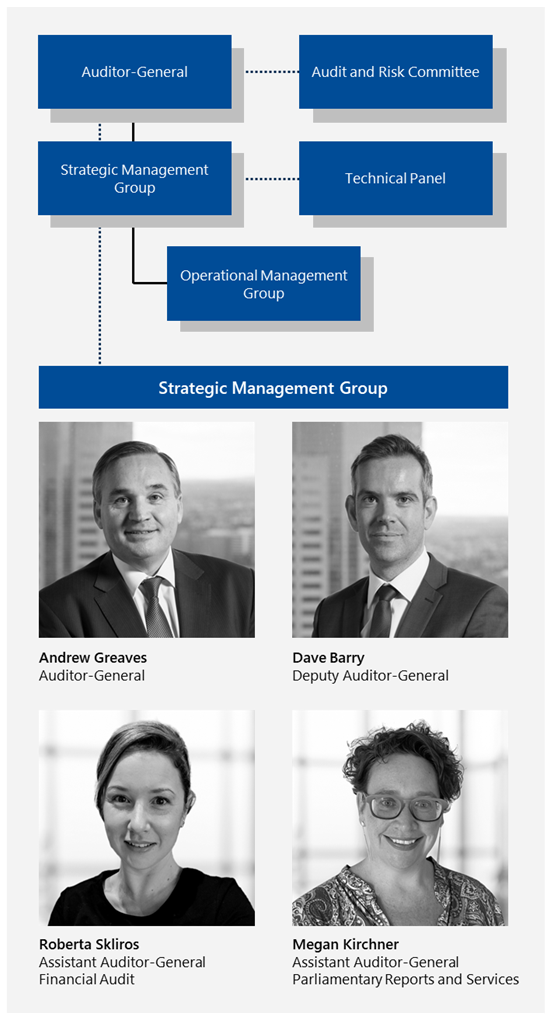
The Audit and Risk Committee independently assesses the effectiveness of VAGO's processes and controls across financial management, performance, sustainability and risk management.
The Operational Management Group leads business and divisional plans to achieve operational objectives, as well as VAGO’s compliance with legislative, regulatory and policy instruments and standards.
The technical panel governs quality by considering significant accounting and auditing matters and their impact on our audit work.
Our people
We recognise that an organisation performs at its best when it understands, respects and celebrates the diverse qualities of its people. We are committed to building a diverse, safe and inclusive workplace, with a workforce that reflects the community we serve.
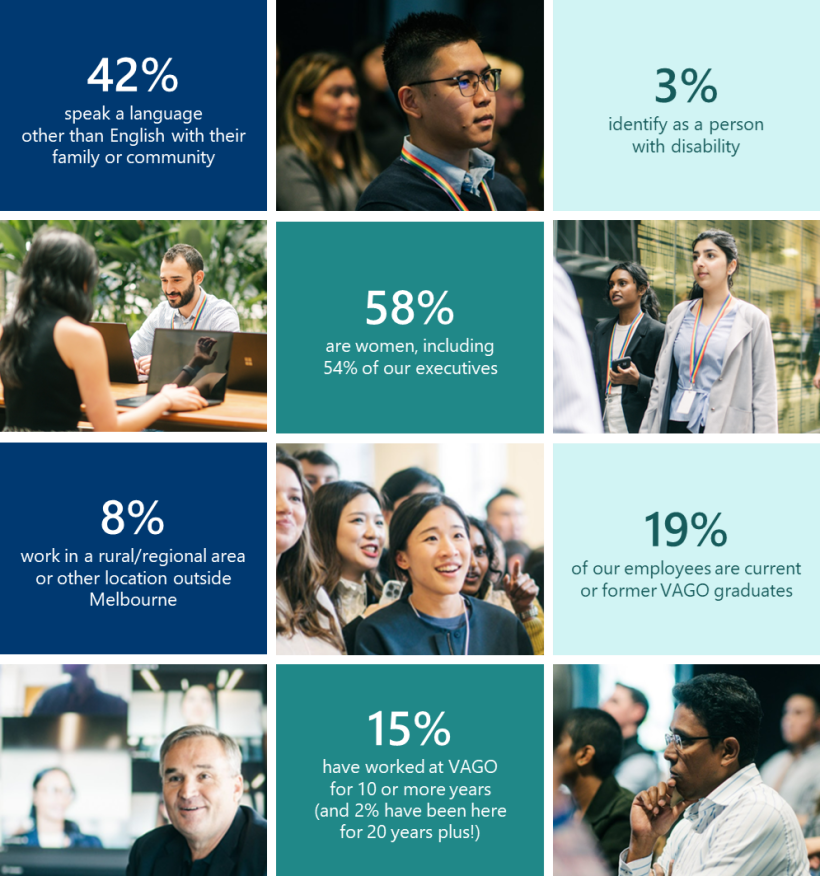
Our workforce
On 30 June 2023, VAGO employed 196 people, comprising:
- 54 in the Performance Audit (PA) division (since renamed to Parliamentary Reports and Services)
- 81 in Financial Audit (FA)
- 61 in audit support:
- 37 in the Office of the Auditor-General (OAG)
- 24 in Corporate Services (CS)
Of our total workforce:
- 58 per cent of our workforce were women (women made up 82 per cent of our part-time workers and 54 per cent of our executives)
- 3 per cent identified as a person with disability.
There are currently no staff who identify as Aboriginal or Torres Strait Islander.
See Appendix A for a detailed profile of the VAGO workforce.
Workplace health and safety
We aim to be an exemplar in safety and wellbeing in the public sector by providing a safe, supportive and respectful workplace.
For more information see Appendix B.
Vision, goals and values
Our vision is better lives for Victorians.
Using our legislated powers, systems and resources, and the skills, knowledge and experience of our people, we work to achieve our goals of a more accountable and transparent public sector and better public services.
This is reflected in our service logic.
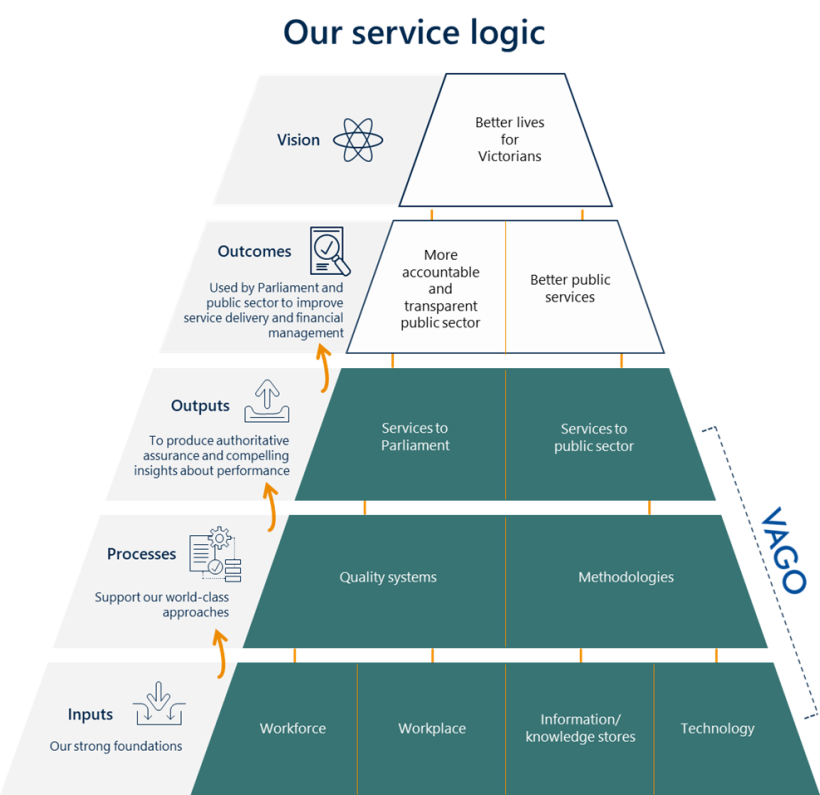
2022–25 strategic plan
Our 2022–25 strategy builds on the work from our ambitious 2017–21 plan, which we did not fully realise due to impacts of the COVID-19 pandemic. While those initiatives and our strategic direction served us well, we continue to look forward. We know we can achieve more and we will adapt to ensure our work remains relevant and effective.
What we do and how we work
Our purpose is to inform Parliament and Victorians about the performance of the public sector and how to improve public services.
Our legislated function
Our sole legislated function is to report on reasonable and limited assurance engagements. Within this defined scope, we undertake:
- performance engagements (audits and reviews) of public sector entities for and on behalf of the Parliament
- attest engagements for the public sector on the financial and non-financial reports they prepare.
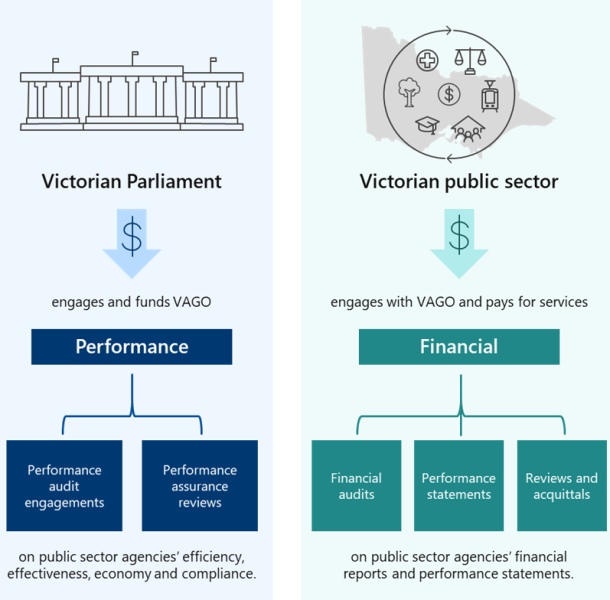
Performance engagements
What we assess
Parliament funds us to determine whether public bodies are achieving their objectives and performing their services and activities effectively, economically, efficiently whilst complying with legislation.
Our ‘follow-the-dollar’ powers
Performance engagements may involve using our ‘follow-the-dollar’ powers, which allow us to audit:
- community sector and for-profit organisations contracted to provide government services
- how government grant recipients use their funds.
Level of assurance
‘Level of assurance’ refers to the measure of the confidence we have in our conclusions. This confidence depends on the source, quality and quantity of evidence we obtain.
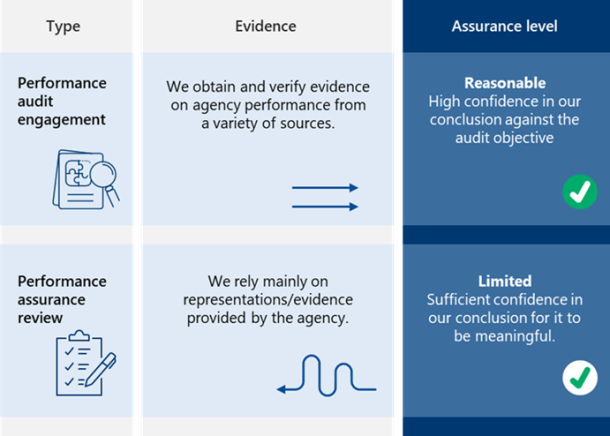
How we select an assurance type
While a performance audit engagement gives the highest level of assurance, a limited assurance review (where we obtain less evidence from agencies) helps us examine and report relatively quickly and cost effectively.
Section 20 of the Audit Act 1994 gives us the power to undertake these reviews, which we generally use to focus on waste, probity and compliance. We can also assess economy, efficiency and effectiveness.
A limited assurance review often has a narrower scope, looking at:
- a specific activity or set of transactions
- a single issue of significant public interest.
We design our work program with the information needs of parliamentarians in mind, taking into account the nature of an issue and level of assurance required.
Financial engagements
How we are engaged
Under the Audit Act 1994 (Audit Act) we must:
- audit all state and local government entities’ annual financial reports and express an audit opinion on them
- where required, audit and express an opinion on local governments’, water authorities’ and TAFEs’ performance reports
- review and express an opinion on the general government sector’s estimated financial reports.
For Parliament, we also prepare sector-based reports on results of audits summarising the outcomes of our financial audits.
Level of assurance
The cost and practicality of achieving absolute assurance is generally not feasible.
The level of assurance that we are able to provide, which is a measure of the confidence we have in our conclusions, depends on the source, quality and quantity of evidence we obtain.
We design our work programs with the information needs of our report users in mind. We consider if we need to provide them with reasonable assurance or if a lower level of assurance may be appropriate, based on:
- reliability
- relevance
- fair presentation
- compliance with the Australian Accounting Standards and relevant legislation.
Attest engagements
For attest engagements, the public sector entity that prepares the financial information is the engaging party and pays for the audit. Each entity’s responsible officer certifies (or attests) that the entity’s financial report is prepared properly and is reliable.
Public entities’ financial reporting frameworks are set by law, while our audit objectives, scope and criteria are set by the Australian Auditing Standards, which we are required to comply with under the Audit Act 1994.
We provide our audit opinion on each attest engagement to the responsible party.
Results of audit reports
Our results of audits reports inform Parliament on the outcome of our financial audits of the local government, TAFE and university sectors. Each report analyses the sector’s financial outcomes and risks to financial sustainability.
The reports also inform Parliament about common control and financial reporting weaknesses in the sector and include recommendations for improvement.
Financial review and acquittals
Financial reviews provide limited assurance that no material modifications need to be made to an entity’s financial report for it to conform with the Australian Accounting Standards and relevant legislation.
Each year, we conduct an assurance review of the estimated financial statements contained in the state Budget. We provide our review opinion to the Treasurer to include in the Budget papers.
We may also be required or invited to provide audit opinions on grant acquittals or controls reports that agencies submit to grant funding bodies.
How we are accountable
We are accountable to the Parliament and all Victorians for how efficiently and effectively we perform our auditing services and how economically we use public resources.
The mechanisms we use to maintain accountability are:
- oversight by the Public Accounts and Estimates Committee (PAEC), including consulting with it on our budget, annual plans and audit specifications
- responding to and reporting on progress against recommendations made by our external financial and performance auditors appointed by PAEC
- publishing our performance measures and targets in Budget Paper 3: Service Delivery
- oversight by the Victorian Inspectorate, including providing six-monthly attestations on the use of our coercive powers
- monitoring and publishing gifts and benefits, and the Auditor-General’s expenses
- voluntarily publishing a transparency report.
External audits of our office
The Audit Act 1994 requires us to be independently audited at least once every 4 years to determine whether the Auditor-General and VAGO are achieving their objectives effectively, economically and efficiently, and in compliance with relevant Acts.
In 2019–20, PAEC appointed Allen and Clark Consulting to conduct this audit. Allen and Clark Consulting tabled its report in Parliament on 4 August 2020, concluding that:
The Auditor-General and VAGO are operating in compliance with all relevant Acts of Parliament. Moreover, the Auditor-General and VAGO are, in all material respects, operating effectively, economically and efficiently and achieving their objectives in compliance under the Act.
We monitor our progress in implementing the report’s 31 recommendations through:
- periodic updates to our Operational Management Group and Audit and Risk Committee
- twice-yearly updates to PAEC.
|
Of the 31 recommendations made to our office in 2020, we … |
At June 30 2023 we have … |
|---|---|
|
accepted:
|
completed:
partially completed:
|
|
did not accept:
|
Reporting our performance
Every year, we report against performance measures and targets agreed with the Assistant Treasurer. The Department of Treasury and Finance publishes our measures and targets each year in Budget Paper 3: Service Delivery, available on the Victorian State Budget website.
Our 2022–23 performance against these measures is covered in the following sections:
- Section 2: A transparent and accountable public sector
- Section 3: Better public services
- Section 5: Performance statement.
This annual report includes our independently audited performance statement.
While we do not have to have this statement audited, we believe it is necessary to promote transparency and better public sector practice. It assures readers that our non-financial performance information is reliable, the same way the independent external audit opinion on our financial report provides assurance.
Oversight by the Victorian Inspectorate
The Victorian Inspectorate (VI) is an oversight body within Victoria’s integrity system, with the power to scrutinise our activities.
It receives and assesses complaints made about us and examines our use of coercive powers. The VI also monitors our compliance with the Audit Act 1994.
We have worked with the VI to develop a self-reporting tool about the exercise of our coercive powers. We did not exercise these powers during the past financial year.
We understand that the VI received no complaints about VAGO in 2022–23.
Monitoring and publishing our expenses
The Standing Directions 2018 under the Financial Management Act 1994 require us to publish our Gifts, Benefits and Hospitality Policy and register on our website.
Our Audit and Risk Committee monitors the Auditor-General’s expenses. To further enhance transparency and accountability, we also voluntarily publish this information on our website.
Transparency report
In January 2023 we released our 2021–22 Transparency Report.
We are not required by law to produce transparency reports. However, we choose to adopt the requirements of the Corporations Act 2001 (to the extent they are relevant and appropriate) and further expand on our annual report disclosures.
Our transparency report details how our quality control system supports our auditors to perform high-quality financial and performance engagements, as well as:
- our investment in audit quality
- our legal structure, governance and finances
- how VAGO’s internal quality control system aligns with the Australian Auditing Standards, relevant ethical requirements and applicable legal and regulatory requirements
- external reviews and audits of VAGO.
Our transparency report is available at www.audit.vic.gov.au/corporate-publications
2. A transparent and accountable public sector
The first goal in our 2022–25 strategic plan is a transparent and accountable public sector.
In this section we detail our work towards achieving that goal.
Improving transparency and accountability
To realise our goal of a more accountable and transparent public sector, our work needs to be relevant and timely, and meet the needs of our audiences.
We also need to advocate strongly for improving financial and non-financial performance across the public sector.
Promoting greater awareness and use of our work
As part of realising our 2022–25 strategic plan, we created a new organisational structure in our performance audit division. We moved from a departmental sector model to a structure that reflects the focus of parliamentary committees.
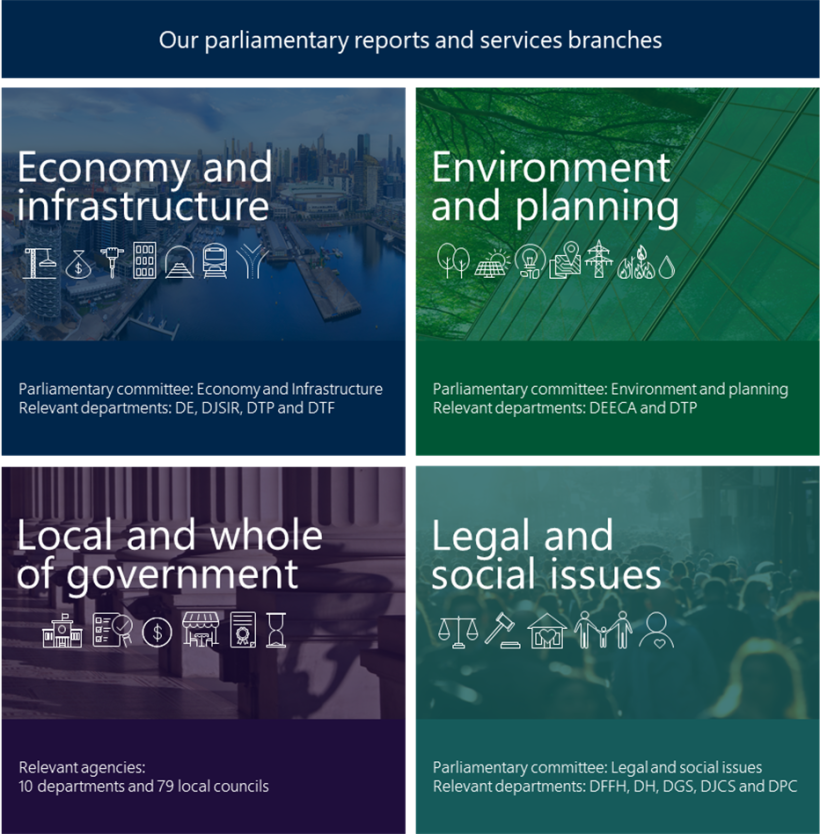
https://new.parliament.vic.gov.au/committees?tab=panel-joint-committees
Focus of our performance engagements
Focus areas
This year, our engagements focused on effectiveness. We have identified ‘using the full breadth of our mandate’ as an area for improvement.
Tabled reports in 2022–23, showing focus areas
| Category | ||||
|---|---|---|---|---|
| Engagement focus | Economy and infrastructure | Environment and planning | Legal and social issues | Local and whole of government |
| Number of reports tabled | 8 | 3 | 6 | 2 |
| Effectiveness | ⬤ ⬤ ⬤ ⬤ ⬤ ⬤ ⬤ ⬤ |
⬤ ⬤ ⬤ | ⬤ ⬤ ⬤ ⬤ ⬤ ⬤ |
⬤ ⬤ |
| Efficiency | ⬤ ⬤ | ⬤ ⬤ | ||
| Economy | ⬤ | |||
| Compliance | ⬤ ⬤ | ⬤ | ⬤ ⬤ | ⬤ ⬤ |
⬤ = primary focus ⬤ = secondary focus
Our planned program of performance audits and reviews
In June 2022 we tabled our 2-year performance audit program plan: for 2022–23 and 2023–24.
In June 2023 we tabled our Annual Plan 2023–24.
Overview
The tables in this section detail our program and status by category for 2022–23 and 2023–2024.
We tabled 16 of our planned 21 reports, with 5 delayed and now tabling in the 2023–24 period. In addition, we:
- added one engagement to our work program after tabling our annual plan
- tabled 3 reports from the prior period.
This represents a significant improvement on the previous year, where the impact of the COVID-19 pandemic on both our office and the public sector saw delays across our program.
Aligning to parliamentary committees
The Parliament of Victoria is a bicameral system, meaning it has 2 houses:
- the Legislative Assembly (LA), with 88 members and 88 districts (one member per district)
- the Legislative Council (LC), with 40 members and 8 regions (5 members per region).
Committees formed by members from one house are either an LA or LC committee. Committees formed by members from both houses are joint committees.
We have organised our Parliamentary Reports and Services division to align with the 3 main LA and LC committees (Economy and Infrastructure, Environment and Planning, and Legal and Social Issues). We have also introduced the local and whole-of-government category for our work that extends beyond the standard parliamentary committee responsibility boundaries.
Planned and delivered reports addressing economy and infrastructure issues
| Status | ||||||||
|---|---|---|---|---|---|---|---|---|
| Category | Audit/review | Planning period | Tabled | In progress | Planned | |||
| Economy and infrastructure | Quality of Major Transport Infrastructure Project Business Cases | 2021–22 | ⬤ | |||||
| Maintaining Railway Assets Across Metropolitan Melbourne | 2022–23 | ⬤ | ||||||
| Effectiveness of Rail Freight Support Programs | 2022–23 | ⬤ | ||||||
| Collecting State-based Tax Revenue | 2022–23 | ⬤ | ||||||
| Supporting Students with Disability | 2022–23 | ⬤ | ||||||
| Principal Health and Wellbeing | 2022–23 | ⬤ | ||||||
| Major Projects Performance Reporting 2022^ | 2022–23* | ⬤ | ||||||
| Eloque: the Joint Venture between DoT and Xerox^ | 2022–23 | ⬤ | ||||||
| Effectiveness of the Tutor Learning Initiative | 2023–24 | ⬤ | ||||||
| Follow-up of Management of the Student Resource Package^ | 2023–24 | ⬤ | ||||||
| Literacy and numeracy achievement outcomes for Victorian students^ | 2023–24 | ⬤ | ||||||
| Delivering Victoria’s Big Housing Build | 2023–24 | ⬤ | ||||||
| Compliance with emergency management requirements: transport | 2023–24 | ⬤ | ||||||
| Effectiveness of arterial road congestion initiatives | 2023–24 | ⬤ | ||||||
| Metro Tunnel Project: phase 3 – systems integration, testing and commissioning | 2023–24 | ⬤ | ||||||
| Major projects performance reporting 2023 | 2023–24 | ⬤ | ||||||
| ⬤ | As planned | ⬤ | Delayed | |||||
^ Assurance review * Added to work program after Annual Plan 2023–24 tabled.
Planned and delivered reports addressing environment and planning issues
| Status | ||||||||
|---|---|---|---|---|---|---|---|---|
| Category | Audit/review | Planning period | Tabled | In progress | Planned | |||
| Environment and planning | Regulating Victoria’s Native Forests | 2022–23 | ⬤ | |||||
| Understanding Victoria’s Contaminated Land^ | 2022–23 | ⬤ | ||||||
| Protecting Victoria’s Coastal Assets: follow-up^ | 2022–23 | ⬤ | ||||||
| Illegal disposal of asbestos-contaminated materials | 2023–24 | ⬤ | ||||||
| Protecting the biosecurity of agricultural plant species | 2023–24 | ⬤ | ||||||
| Developing Fishermans Bend | 2023–24 | ⬤ | ||||||
| Domestic building oversight part 1: regulation^ | 2023–24 | ⬤ | ||||||
| Domestic building oversight part 2: dispute resolution | 2023–24 | ⬤ | ||||||
| ⬤ | As planned | ⬤ | Delayed | |||||
^ Assurance review
Planned and delivered reports addressing legal and social issues
| Status | ||||||||
|---|---|---|---|---|---|---|---|---|
| Category | Audit/review | Planning period | Tabled | In progress | Planned | |||
| Legal and social | Victoria's Alcohol and Other Drug Treatment Data | 2021–22 | ⬤ | |||||
| The Effectiveness of Victoria Police's Staff Allocation | 2022–23 | ⬤ | ||||||
| Quality of Child Protection Data | 2022–23 | ⬤ | ||||||
| Maintaining the Mental Health of Child Protection Practitioners: follow-up^ | 2022–23 | ⬤ | ||||||
| Correctional Services for People with Intellectual Disability or an Acquired Brain Injury | 2022–23 | ⬤ | ||||||
| Supporting Sexual and Reproductive Health | 2022–23 | ⬤ | ||||||
| Staff wellbeing in Fire Rescue Victoria | 2022–23 | ⬤ | ||||||
| Reducing the harm caused by drugs on Victorian roads | 2022–23 | ⬤ | ||||||
| Access to emergency healthcare | 2023–24 | ⬤ | ||||||
| Employee health and wellbeing in Victorian public hospitals | 2023–24 | ⬤ | ||||||
| Guardianship and decision-making for vulnerable adults | 2023–24 | ⬤ | ||||||
| ⬤ | As planned | ⬤ | Delayed | |||||
^ Assurance review
Planned and delivered reports addressing local and whole-of-government issues
| Status | ||||||||
|---|---|---|---|---|---|---|---|---|
| Category | Audit/review | Planning period | Tabled | In progress | Planned | |||
| Local and whole-of-government | Regulating Private Pool and Safety | 2022–23 | ⬤ | |||||
| Regulating Food Safety | 2022–23 | ⬤ | ||||||
| Contractors and consultants in the Victorian Public Service: spending | 2022–23 | ⬤ | ||||||
| Cybersecurity: Cloud Computing Platforms | 2022–23 | ⬤ | ||||||
| Responses to Performance Engagement Recommendations: Annual Status Update 2023^ | 2022–23 | ⬤ | ||||||
| Fair Presentation of Service Delivery Performance 2022^ | 2022–23 | ⬤ | ||||||
| Fair presentation of service delivery performance 2023^ | 2023–24 | ⬤ | ||||||
| Responses to performance engagement recommendations: annual status update* | 2023–24 | ⬤ | ||||||
| Assuring the integrity of the Victorian Government’s procurement activities | 2023–24 | ⬤ | ||||||
| Managing employee performance in the Victorian Public Service | 2023–24 | ⬤ | ||||||
| Managing state-significant risks | 2023–24 | ⬤ | ||||||
| Financial management of local councils | 2023–24 | ⬤ | ||||||
| ⬤ | As planned | ⬤ | Delayed | |||||
^ Assurance review
Performance audits and reviews tabled in 2022–23
This year we tabled 14 performance audits and 5 reviews in Parliament.
We highlighted key governance issues, monitoring and reporting challenges, and instances of poor financial discipline. We also drew attention to successes and examples of good practices, including where we believe the public sector could learn from and follow methods and approaches.
Machinery of government changes
For some of our audits and reviews, the departments we examined were impacted by machinery of government (MoG) changes.
Central government departments showing MoG changes
| Department | MoG changes | |
|---|---|---|
| DE | Department of Education | Previously Department of Education and Training (DET). Training now falls under DJSIR. |
| DEECA | Department of Energy, Environment and Climate Action | Previously Department of Environment, Land, Water and Planning (DELWP). |
| DFFH | Department of Families, Fairness and Housing | Previously Department of Health and Human Services (DHHS)*. |
| DH | Department of Health | |
| DGS | Department of Government Services | New department responsible for selected functions previously performed by DPC and DTF. |
| DJCS | Department of Justice and Community Safety | No change. |
| DJSIR | Department of Jobs, Skills, Industry and Regions | Previously Department of Jobs, Precincts and Regions (DJPR). |
| DPC | Department of Premier and Cabinet | No change. |
| DTF | Department of Treasury and Finance | No change. |
| DTP | Department of Transport and Planning | Previously Department of Transport (DoT). Planning function previously fell under DELWP. |
Note: * This change occurred on 1 February 2021.
Source: VAGO.
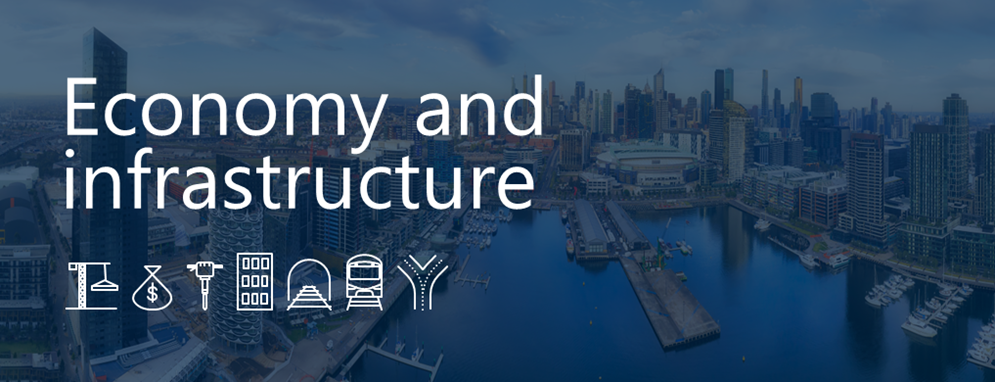
The Parliamentary Economy and Infrastructure Committees can examine issues referred by the Legislative Assembly related to education and training, the economy, jobs, regions and transport.
The Committee can examine matters connected with the departments of Education (DE), Jobs, Skills, Industry and Regions (DJSIR), Transport and Planning (DTP) and Treasury and Finance (DTF).
Economy and infrastructure engagements
We conducted 8 economy and infrastructure engagements – 6 reasonable assurance engagements (audits) and 2 limited assurance reviews. The summaries in this section give a snapshot of each of these reports.
Reasonable assurance engagements (audits)
Reasonable assurance engagements tabled in 2022–23 (Economy and infrastructure)
| Audit focus | |||||
|---|---|---|---|---|---|
| Audit report | Tabled | Effectiveness | Efficiency | Economy | Compliance |
| Quality of Major Transport Infrastructure Project Business Cases | September 2022 | ⬤ | ⬤ | ⬤ | |
| Maintaining Railway Assets Across Metropolitan Melbourne | March 2023 | ⬤ | |||
| Effectiveness of Rail Freight Support Programs | June 2023 | ⬤ | ⬤ | ||
| Collecting State-based Tax Revenue | June 2023 | ⬤ | ⬤ | ||
| Supporting Students with Disability | June 2023 | ⬤ | |||
| Principal Health and Wellbeing | June 2023 | ⬤ | |||
⬤ = primary focus ⬤ = secondary focus

Quality of Major Transport Infrastructure Project Business Cases
We looked at whether business cases for major transport infrastructure projects support informed investment decisions.
Transport infrastructure projects make up around 70 per cent of the state’s planned capital expenditure.
What we concluded
Business cases for 3 of the 4 projects we reviewed do not support fully informed investment decisions.
The audited agencies’ business case development and oversight processes for the projects were usually consistent with DTF and agency requirements. However, 3 business cases lacked sufficient analysis of alternative project options, and 2 lacked an assessment of the value for money the projects could provide under different scenarios. Agencies provided other advice but did not finalise these 3 business cases until after the government made significant financial commitments to them.
Without a comprehensive business case, decision-makers do not know whether the investments they make will maximise benefits to Victorian communities.
We examined 4 transport infrastructure business cases against DTF’s Investment Lifecycle and High Value High Risk (ILHVHR) guidelines: Suburban Rail Loop (SRL) rail and precinct development project, Melbourne Airport Rail (MAR) project, Barwon Heads Road Upgrade and Mickleham Road Upgrade.
Engagement type: Reasonable assurance audit. Tabled: September 2022

Maintaining Railway Assets Across Metropolitan Melbourne
We looked at whether Melbourne’s metropolitan railway assets are maintained to deliver safe, reliable and punctual train services, and to optimise asset cost and performance.
Melbourne’s trains rely on a range of supporting infrastructure and technology. DTP pays private operator Metro Trains Melbourne (Metro) $2.7 billion to maintain and renew these supporting assets over a 7-year franchise agreement.
What we concluded
Metro is maintaining Melbourne’s metropolitan railway infrastructure and technology to support reliable and punctual train services and keep passengers safe. However, DTP has not assessed whether Metro is optimising asset costs, and if the current maintenance and renewal approach will sustain asset performance in the long-term.
DTP does not have a long-term strategy for its railway infrastructure and technology assets. It also does not have an effective way to measure asset performance and assess Metro’s work. DTP needs this information to ensure the current agreement and any future contracts deliver value for money.
Engagement type: Reasonable assurance audit. Tabled: March 2023

Effectiveness of Rail Freight Support Programs
We looked at whether 2 programs to encourage more freight on rail have been effective: the Mode Shift Incentive Scheme and the Port Rail Shuttle Network.
The 2018 Delivering the Goods – Victorian Freight Plan confirmed the government’s intention to increase the share of freight moved by rail rather than road. Despite this, the share of rail freight going in and out of the Port of Melbourne by rail is now less than half its 2013–14 peak.
What we concluded
The department’s 2 programs have not yet fully realised the government’s intention to move more freight by rail.
Although the Mode Shift Incentive Scheme has kept some containers on trains that would have likely gone to trucks, it has not increased rail’s share of container freight in regional areas.
Delays in delivering the Port Rail Shuttle Network facilities and services mean the social, economic and environmental benefits from diverting metropolitan containers from road to rail are also delayed.
Engagement type: Reasonable assurance audit. Tabled: June 2023

Collecting State-based Tax Revenue
We looked at whether DTF and the State Revenue Office (SRO) are optimising how they collect state-based tax revenue.
The government uses these taxes to fund essential public services, such as education, healthcare, infrastructure, police and public transport. It is therefore essential that SRO collects tax effectively and efficiently.
What we concluded
Despite many positive initiatives in recent years to better meet taxpayer needs, SRO and DTF cannot show that SRO has optimised how it collects tax.
SRO reliably collects the tax it knows about and the amount it collects has increased over the last 5 years. However, there is a very high likelihood that SRO could collect more tax by better analysing how effectively it is reducing the tax gap, which is the difference between the tax people and businesses owe and what they actually pay.
SRO does not do enough analysis to determine if it is collecting taxes efficiently. DTF and SRO's public performance measures do not give a clear picture of SRO's performance. DTF's governance of SRO's performance also requires clarification.
Engagement type: Reasonable assurance audit. Tabled: June 2023

Supporting Students with Disability
We looked at whether DE’s Disability Inclusion (DI) program is set up to provide reasonable adjustments that allow students with disability to access and participate in education on the same basis as students without disability.
About one quarter of all Victorian students receive reasonable adjustments at school due to disability.
What we concluded
The department’s DI program is designed to provide reasonable adjustments that allow students with disability and diverse learning needs to access and participate in education on the same basis as students without disability. However, some regions and areas are not implementing the program as effectively as others. In these cases, schools are less likely to take up all DI elements and put them into practice as the department intended.
The department's oversight of the program rollout means it is addressing barriers to implementation and continually improving DI for schools. Building on its program oversight and monitoring in the regions will help improve access and participation in education for students with a disability and diverse learning needs.
Engagement type: Reasonable assurance audit. Tabled: June 2023

Principal Health and Wellbeing
We looked at whether DE is protecting the health and wellbeing of its school principals.
As their employer, the department is responsible for protecting the health and wellbeing of all government school employees, including school principals, so far as is reasonably practicable. Principals experience worse health and wellbeing outcomes than the general population, especially relating to stress, burnout and sleeping troubles. They also experience mental injury more often than other school staff.
What we concluded
The department is not effectively protecting the health and wellbeing of its school principals.
The department has identified the key challenges that principals face. It has developed numerous strategies and initiatives to address them. Many principals use and appreciate these services. However, they have not improved principals' health and wellbeing.
The department needs to do more to reduce principal workload if it is to achieve better outcomes. The department also needs to better monitor, evaluate and report on those outcomes. It will then better understand principals’ health and wellbeing and whether its initiatives are leading to desired outcomes.
Engagement type: Reasonable assurance audit. Tabled: June 2023
Limited assurance reviews
In addition to our issue-based engagements, which are different each year, we table a series of regular reviews.
In the economy and infrastructure category, we conduct yearly reviews on 2 aspects of public sector performance reporting: major projects and service delivery.
This year we did not conduct any other limited assurance reviews on economy and infrastructure topics.
Limited assurance reviews tabled in 2022–23 (Economy and infrastructure)
| Audit focus | |||||
|---|---|---|---|---|---|
| Review report | Tabled | Effectiveness | Efficiency | Economy | Compliance |
| Major Projects Performance Reporting 2022 | September 2022 | ⬤ | |||
| Fair Presentation of Service Delivery Performance 2022 | March 2023 | ⬤ | ⬤ | ||
⬤ = primary focus ⬤ = secondary focus

Major Projects Performance Reporting 2022
We looked at whether the public sector transparently reports the performance of major projects against cost, time, scope and benefits.
As of May 2022, Victoria had committed to investing $184 billion in capital projects. This is a net increase of $40 billion from the same time last year. When the government spends public money on a major project, Parliament and the community deserve a clear explanation of the project’s progress and outcomes.
What we concluded
DTF and public sector entities do not consistently report on major projects’ performance in a transparent way. Without this information, Parliament and the community cannot hold responsible entities accountable.
We published a data analytics dashboard with this report. It shows how DTF could help Parliament and the community better understand how entities are managing Victoria's major projects.
Engagement type: Limited assurance review. Tabled: September 2022

Fair Presentation of Service Delivery Performance 2022
We looked at whether the public sector fairly presents its service delivery performance information.
The government spends public money to deliver goods and services to Victorians. Parliament and the community require accurate and fair reporting of the performance of those services.
What we concluded
Service delivery performance is not clearly visible to Parliament and the community. Departments do not fully follow the requirements of DTF’s Resource Management Framework (RMF), and DTF’s Budget Paper No. 3: Service Delivery (BP3) includes too much information that is not relevant to output budgeting. This extra information detracts from the primary purpose of BP3 and makes it harder to discern how well departments are delivering services.
Nothing came to our attention to indicate that departments’ performance information is not accurate and reliable.
Engagement type: Limited assurance review. Tabled: March 2023

The Parliamentary Environment and Planning Committees can examine matters connected with the Department of Energy, Environment and Climate Action (DEECA) and the Department of Transport and Planning and their related agencies.
Environment and planning engagements
We conducted 3 environment and planning engagements – one reasonable assurance engagement (audit) and 2 limited assurance reviews.
Reasonable assurance engagements (audits)
Reasonable assurance engagement tabled in 2022–23 (Environment and planning)
| Audit focus | |||||
|---|---|---|---|---|---|
| Audit report | Tabled | Effectiveness | Efficiency | Economy | Compliance |
| Regulating Victoria’s Native Forests | October 2022 | ⬤ | |||
⬤ = primary focus

Regulating Victoria’s Native Forests
We looked at whether the Office of the Conservation Regulator (OCR) effectively regulates timber harvesting operations.
Victoria’s native forests are precious natural assets, providing environmental, health and wellbeing, cultural and socio-economic benefits. Effective regulation of timber harvesting is crucial to ensure this resource is protected for future generations. The government established the OCR in 2019 to improve timber harvesting regulation and ensure harvesting does not adversely affect other forest values.
What we concluded
The OCR has made progress in improving timber harvesting regulation. However, it has further work to do to address the weaknesses in its systems, processes and reporting. This will support strong regulatory outcomes and improve its effectiveness in regulating timber harvesting in Victoria’s native forests.
Engagement type: Reasonable assurance audit. Tabled: October 2022
Limited assurance reviews
This year, our environment and planning work included 2 limited assurance reviews, one of which was a follow-up review, where we examine whether agencies are effectively responding to our recommendations from an earlier report.
Limited assurance reviews tabled in 2022–23 (Environment and planning)
| Audit focus | |||||
|---|---|---|---|---|---|
| Review report | Tabled | Effectiveness | Efficiency | Economy | Compliance |
| Follow-up of Protecting Victoria's Coastal Assets | August 2022 | ⬤ | |||
| Understanding Victoria’s Contaminated Land | March 2023 | ⬤ | ⬤ | ||
⬤ = primary focus ⬤ = secondary focus

Follow-up of Protecting Victoria’s Coastal Assets
We looked at whether DELWP (now DEECA) has effectively responded to the recommendations from our 2018 audit Protecting Victoria’s Coastal Assets.
DEECA has oversight of over 1,500 coastal protection assets (CPAs), with a total value of approximately $1.13 billion. With climate change increasing the frequency and severity of erosion and inundation, it is timely to review the department’ progress in addressing our 2018 audit.
What we concluded
Based on the evidence we obtained, nothing has come to our attention that the department has not addressed our recommendations for collection and management of CPA data and coastal hazard and risk assessment. It has also improved its asset management practices.
While DELWP has made progress, it is yet to complete addressing our recommendations relating to oversight and support for coastal managers and developing a sustainable funding model.
Engagement type: Limited assurance review (follow up). Tabled: August 2022

Understanding Victoria’s Contaminated Land
We looked at whether data on contaminated land published by DEECA and the Environment Protection Authority (EPA) is accurate, current and fit for purpose.
The government and community need to know if a site is contaminated so they can manage risks and plan how to use and develop the land. In 2019, DEECA and the EPA launched Victoria Unearthed to create and maintain a database of potentially contaminated sites.
What we concluded
Victoria Unearthed (VU) fulfils a 2016 inquiry recommendation to create a statewide database of potentially contaminated sites. However, it is not meeting its full potential to provide accurate, current and fit-for-purpose data about contaminated land. This is because DEECA and EPA have not evaluated if VU continues to meet users' needs, and VU has not kept all of its datasets complete and up to date.
Engagement type: Limited assurance review. Tabled: March 2023

The Parliamentary Legal and Social Issues Committees can examine matters connected with the departments of Families, Fairness and Housing (DFFH), Health (DH), Government Services (DGS), Justice and Community Safety (DJCS) and Premier and Cabinet (DPC).
Legal and social issues engagements
We conducted 6 legal and social issues engagements – 5 reasonable assurance engagements (audits) and one limited assurance review.
Reasonable assurance engagements (audits)
Reasonable assurance engagements tabled in 2022–23 (Legal and social issues)
| Audit focus | |||||
|---|---|---|---|---|---|
| Report | Tabled | Effectiveness | Efficiency | Economy | Compliance |
| The Effectiveness of Victoria Police's Staff Allocation | September 22 | ⬤ | ⬤ | ⬤ | |
| Quality of Child Protection Data | September 2022 | ⬤ | ⬤ | ||
| Victoria's Alcohol and Other Drug Treatment Data | October 2022 | ⬤ | |||
| Supporting Sexual and Reproductive Health | May 2023 | ⬤ | |||
| Correctional Services for People with Intellectual Disability or an Acquired Brain Injury | June 2023 | ⬤ | ⬤ | ||
⬤ = primary focus ⬤ = secondary focus

The Effectiveness of Victoria Police’s Staff Allocation
We looked at whether Victoria Police understands its frontline staffing needs and uses this information to make resourcing decisions aligned to its strategic objectives.
Victoria Police plays a critical role in ensuring a safe and secure society and the government invests significant money in its staffing. Victoria Police uses most of this funding for sworn officers.
What we concluded
Victoria Police’s staffing needs are not clear because it does not have a strategic workforce plan. It does not have any modelling or forecasting to understand or plan for its staffing requirements – both current and long-term. Without knowing its future staffing needs, Victoria Police continues to rely on what it receives from the government, rather than providing evidence-based advice.
Victoria Police also cannot assure itself or the community that the 2,729 additional police officers it received as part of the $2 billion Community Safety Statement (CSS) program delivered community safety outcomes. This is because the CSS program only had a short-form business case which was inadequate for the size of the investment. This diminishes transparency and information for decision makers. Victoria Police has not since attempted to assess the incremental benefits realised from the investment.
Engagement type: Reasonable assurance engagement. Tabled: September 2022

Quality of Child Protection Data
We looked at whether DFFH has adequate controls to ensure that data in its Client Relationship Information System (CRIS) is reliable.
CRIS is central to how the department delivers child protection services. DFFH needs to ensure CRIS data is high quality so it can fulfil its obligations to vulnerable children and support its policies and decisions.
What we concluded
DFFH does not have adequate controls to ensure its child protection data is high quality.
We found examples of incomplete, inaccurate and inconsistent data. This means that DFFH may not have easy access to reliable data to help it make decisions about vulnerable children. These data quality issues may also prevent DFFH from using the data to monitor children's progress in out of home care.
Factors that contribute to poor quality data include that DFFH's child protection data does not comply with government data quality standards, CRIS is not fit for its intended purpose, and CRIS’s data quality controls do not always work. Also, the workloads of CRIS users limit their capacity to correctly record information about children in a timely way.
DFFH told us that it is aware of these issues and is working on a plan to address them.
Engagement type: Reasonable assurance engagement. Tabled: September 2022

Victoria's Alcohol and Other Drug Treatment Data
We looked at whether the DH’s Victorian Alcohol and Drug Collection (VADC) dataset is high quality and achieving its intended benefits.
In 2020–21, over 40,000 Victorians accessed alcohol and other drug services through DH-funded providers. DH needs accurate data to make sure these services are effectively helping Victorians.
What we concluded
Data in the VADC does not accurately represent what service providers are doing for their clients.
DH is responsible for the quality of VADC data and is working to improve it. However, there is a risk that DH's improvement program will not address all the root causes of the data quality issues, including service providers' limited data capabilities and capacities, and variation in the information technology systems they use to collect data.
Poor-quality data limits DH’s ability to use it to plan services and manage providers' performance. It also means that service providers need to incur significant costs to address data quality issues.
Engagement type: Reasonable assurance engagement. Tabled: October 2022

Supporting Sexual and Reproductive Health
We looked at whether Victorian women can readily access sexual and reproductive health (SRH) information and services to support their health and wellbeing.
Women need access to SRH services to stay well and make critical choices about their lives, including if and when to have children. Since 2017, the government has set up 1800 My Options (a phone line and website) and 11 hubs (clinics). Victorians need to know if these programs are improving access to information and services, particularly for those in identified priority groups.
What we concluded
There are areas in Victoria where women cannot readily access SRH services.
While the 1800 My Options service allows Victorian women to readily access SRH information, the department does not know if its hubs are improving women and priority groups' access to SRH services. This is because it does not have a full understanding of service gaps and demand across the state or performance measures to monitor the hubs' ability to improve service access.
Engagement type: Reasonable assurance engagement. Tabled: May 2023

Correctional Services for People with Intellectual Disability or an Acquired Brain Injury
We looked at whether the corrections system meets the needs of people with intellectual disability or an acquired brain injury.
These prisoners are overrepresented in the corrections system and have history of returning to prison more often. It is important they get support to be safe in prison and to prepare them for life back in the community.
What we concluded
The corrections system does not fully meet the needs of people with intellectual disability or an acquired brain injury.
DJCS does not know how many prisoners have intellectual disability or an acquired brain injury and, of these, how many require specialised support. Both DJCS and DFFH have long waiting lists for programs and not enough specialised beds. So some prisoners will continue to miss out on services that could reduce their risk of reoffending.
Engagement type: Reasonable assurance engagement. Tabled: June 2023
Limited assurance reviews
Limited assurance reviews tabled in 2022–23 (Legal and social issues)
| Audit focus | |||||
|---|---|---|---|---|---|
| Audit report | Tabled | Effectiveness | Efficiency | Economy | Compliance |
| Follow-up of Maintaining the Mental Health of Child Protection Practitioners | March 2023 | ⬤ | |||
⬤ = primary focus

Follow-up of Maintaining the Mental Health of Child Protection Practitioners
We looked at whether DFFH effectively responded to the recommendations from our 2018 audit Maintaining the Mental Health of Child Protection Practitioners.
Our 2018 audit found that unreasonable workloads had created workplace stressors that were harming the mental health of Child Protection Practitioners (CPPs). This undermined the effectiveness of their crucial and challenging frontline work.
What we concluded
Nothing has come to our attention that DFFH has not satisfactorily addressed our recommendations to: assess the effectiveness of current support tools, deliver specialised support services, and promote awareness of available support services and processes for raising mental health concerns.
While DFFH has made progress, it has more work to do to acquit our recommendations to advise government about risks and resources needed, improve demand forecasting, monitor CPP mental health more holistically, and improve CPPs' experiences in the court environment.
As a result, despite positive intent and action, the CPP workforce remains under-resourced, under supervised, and under pressure.
Engagement type: Limited assurance review. Tabled: September 2022
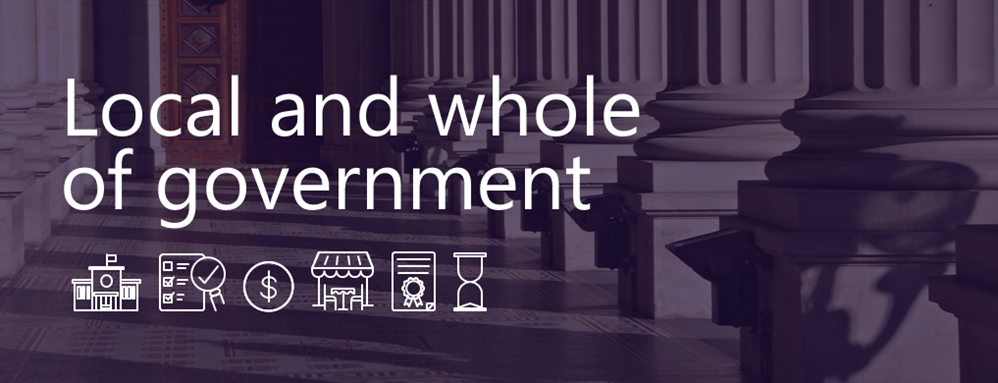
Our Local and whole-of-government branch includes our work that extends beyond the standard parliamentary responsibility boundaries.
It includes our work across the 79 local government councils, as well as thematic or broad engagements and reviews connected with multiple cross-committee related agencies.
Local and whole-of-government engagements
We conducted 2 local and whole-of-government reasonable assurance engagements.
Reasonable assurance engagements (audits)
Reasonable assurance engagements tabled in 2022–23 (local and whole-of-government)
| Audit focus | |||||
|---|---|---|---|---|---|
| Report | Tabled | Effectiveness | Efficiency | Economy | Compliance |
| Regulating Private Pool and Spa Safety | February 2023 | ⬤ | ⬤ | ||
| Regulating Food Safety | June 2023 | ⬤ | ⬤ | ||
⬤ = primary focus ⬤ = secondary focus

Regulating Private Pool and Spa Safety
We looked at whether councils effectively implement private pool and spa safety barrier regulations.
Safety barriers can prevent young children drowning. Regulations require owners to register their pools and spas with their local council and certify their barriers comply with safety standards.
What we concluded
Councils cannot be sure they have found and minimised all potential safety risks associated with private pools and spas in their municipalities. This is because not all owners have registered their pools and spas and/or had certified their safety barriers by the due date.
The backlog of outstanding registrations and certifications will also make it difficult for councils to manage future certification deadlines.
Engagement type: Reasonable assurance engagement. Tabled: February 2023

Regulating Food Safety
We looked at whether councils are complying with their legislative responsibilities for food safety to protect public health.
Robust food safety regulation and enforcement is necessary to prevent illness, hospitalisation and death caused by foodborne illness.
What we concluded
Audited councils are not complying with all their legislative responsibilities for food safety to protect public health. Not all audited councils are assessing or inspecting all food premises, systematically identifying unregistered food premises, meeting food sampling targets or reporting data to DH. Also, not all audited councils are reinspecting 3 months before registration renewal for all noncompliant food premises or those with complaints.
Engagement type: Reasonable assurance engagement. Tabled: June 2023
Embedding our work: Follow-up inquiries and reviews
Under the Parliamentary Committees Act 2003 (Vic), the Public Accounts and Estimates Committee (PAEC) is responsible for conducting follow-up inquiries on selected VAGO audits.
We also conduct follow-up reviews of selected audits as well as a yearly review of how agencies are implementing our performance audit recommendations.
PAEC follow-up inquiries
Through follow-up inquiries, PAEC examines the progress that has been made implementing audit recommendations, identifies any issues with implementation, and investigates new issues that may have arisen since the report was tabled.
In April 2023 PAEC resolved to conduct a follow up inquiry into our:
- 2019 Follow up of Regulating Gambling and Liquor report
- 2021 Reducing the Harm Caused by Gambling report.
PAEC conducted hearings for this inquiry in July 2023.
Our follow-up reviews
We also conduct our own follow-up reviews of selected reports.
In 2022–23 we conducted 2 limited assurance follow-up reviews:
- Follow-up of our 2018 audit Maintaining the Mental Health of Child Protection Practitioners
- Follow-up of our 2018 audit Protecting Victoria’s Coastal Assets.
In 2023–24 we plan to conduct a follow-up review of our 2020 audit Management of the Student Resource Package.
Increasing our engagement
Our primary stakeholders are parliamentarians, the public sector agencies we audit and the Victorian community. We are continually seeking better ways to engage with our stakeholders, including tailoring information to meet their needs.
We also actively engage with our peers and the accounting and auditing professions.
Sharing our work online and through social media
Our digital media goals
Our digital media engagement goals are to:
- continue finessing the way we identify and engage with our audience across multiple channels
- promote and share our work to increase the reach and impact of our products
- become an employer of choice and deliver improved recruitment and talent acquisition outcomes.
Uplifting digital engagement
This year we continued to uplift our digital engagement, marketing activities and social media presence. This included:
- updating the way we present our reports on our website, improving the experience for our audience
- refining the messaging in our video summaries (shared on YouTube with links from our website, subscriber emails and other social media), to provide the most relevant information to our often time-poor audience
- transitioning to a new email platform for our external communications, both to improve the reader experience and to give us a better understanding of recipient engagement (parliamentarians and subscribers).
Our key platforms
We proactively share content across multiple channels; our website, YouTube and social media channels.
The table below summarises engagement levels across our 3 main platforms: our website, YouTube and LinkedIn.
The popularity of some of our older videos indicates that interest in our work extends long after we table a report in Parliament.
Engagement with our communications platforms
| Platform | Main purpose | Engagement (and comparison with last year where available) | Top report pages/posts |
|---|---|---|---|
|
VAGO website |
Present, share and display our past and future work program. |
|
|
|
YouTube (report summary videos) |
Host and share summary videos, such as tabled reports and industry forums. |
Total views: 26,663 (+5.6%) |
|
|
|
Promote VAGO to potential employees and graduates. Build community understanding of our overall purpose and work. Share information about tabled reports and supporting products, such as data analytics dashboards and summary videos. |
Total followers: 6,558 (+24%) |
Other online platforms
This year, we increased activity on Facebook, Instagram and X (previously named Twitter).
These platforms promote VAGO and our work to members of the public and the media.
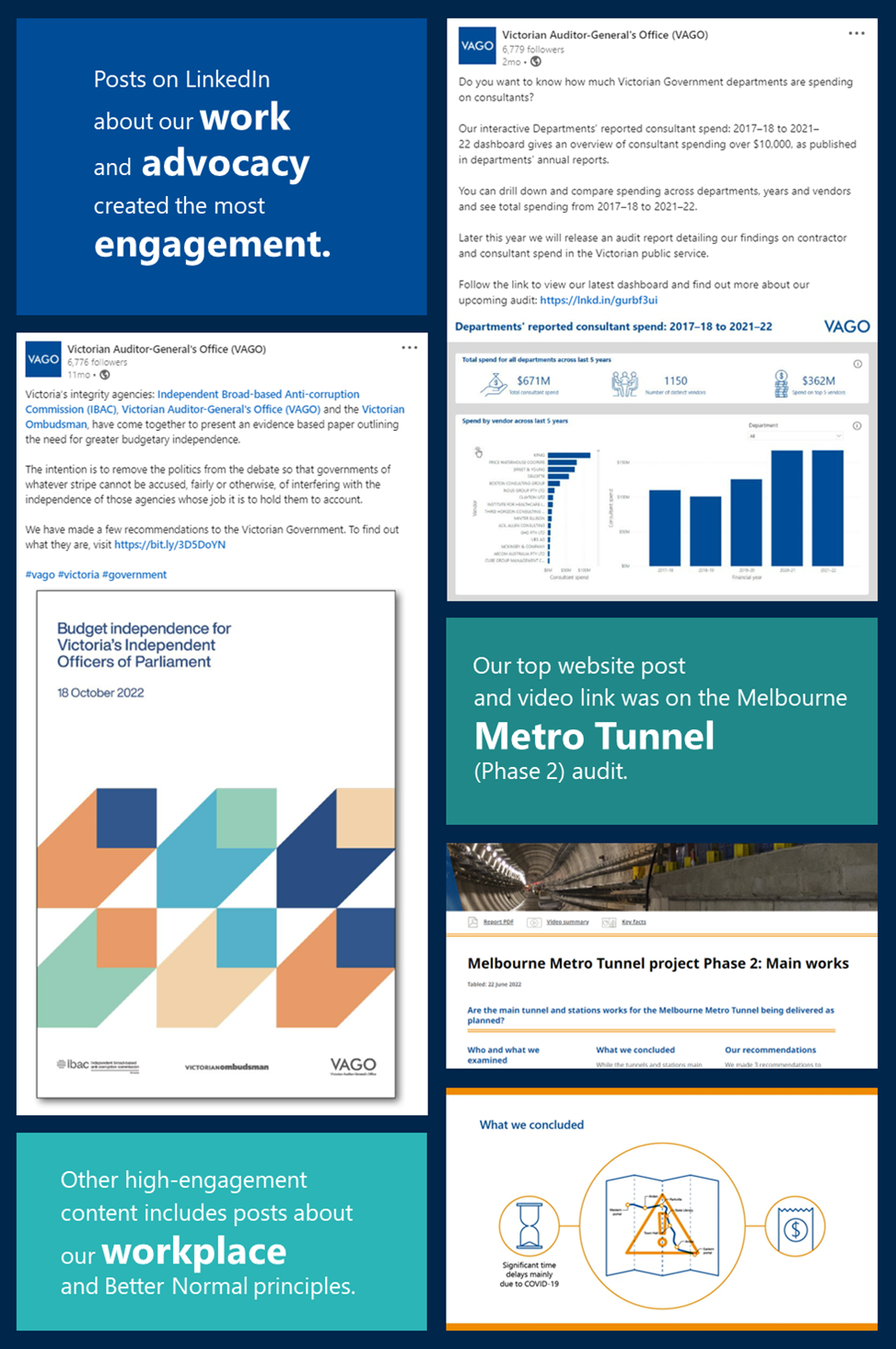
Listening to our stakeholders
Engaging with PAEC
We engaged with PAEC throughout the year, including on annual planning and audit topic selection. PAEC provided valuable feedback on our forward audit program, including ideas about potential areas of audit interest.
Briefing ministers and parliamentarians
This year, we made changes to the way we brief parliamentarians on tabled reports. This was due in part to parliamentarians missing briefings due to their workload and schedules.
Instead of running one briefing on the day a report is tabled, we now offer individual briefings to parliamentarians and their staff, either online or in person at a time that suits them. These briefings outline our audit findings and give an MP the opportunity to ask questions on areas of interest.
Moving to this tailored approach has seen an increase in engagement.
Responding to enquiries
We also responded to enquiries from parliamentarians throughout the year. On average, we took 26.3 days to finalise a response, missing our target of 20 days or fewer.
Survey of parliamentarians
We did not survey parliamentarians this year given the timing of the 2022 election and parliament sitting dates recommencing in February 2023.
Instead, we worked with the parliamentary members services team to deliver a dedicated ‘lunch and learn’ session for new and returning members of parliament in May 2023.
The Strategic Management Group presented a briefing to parliamentarians and their staff on our office’s powers and functions, our recently tabled reports and our planned future program.
We will continue to work with members of parliament to enhance our products and services, and to make them more accessible, readable and relevant.
Survey of audited agencies (performance audits)
After each performance engagement, we ask the agencies involved how they rate our processes, reporting and value. Overall satisfaction for 2022–23 tabled audits was 77 per cent, meeting our target of 75 per cent and an improvement on last year’s result of 72 per cent.
Overall satisfaction for performance auditees for 2022–23
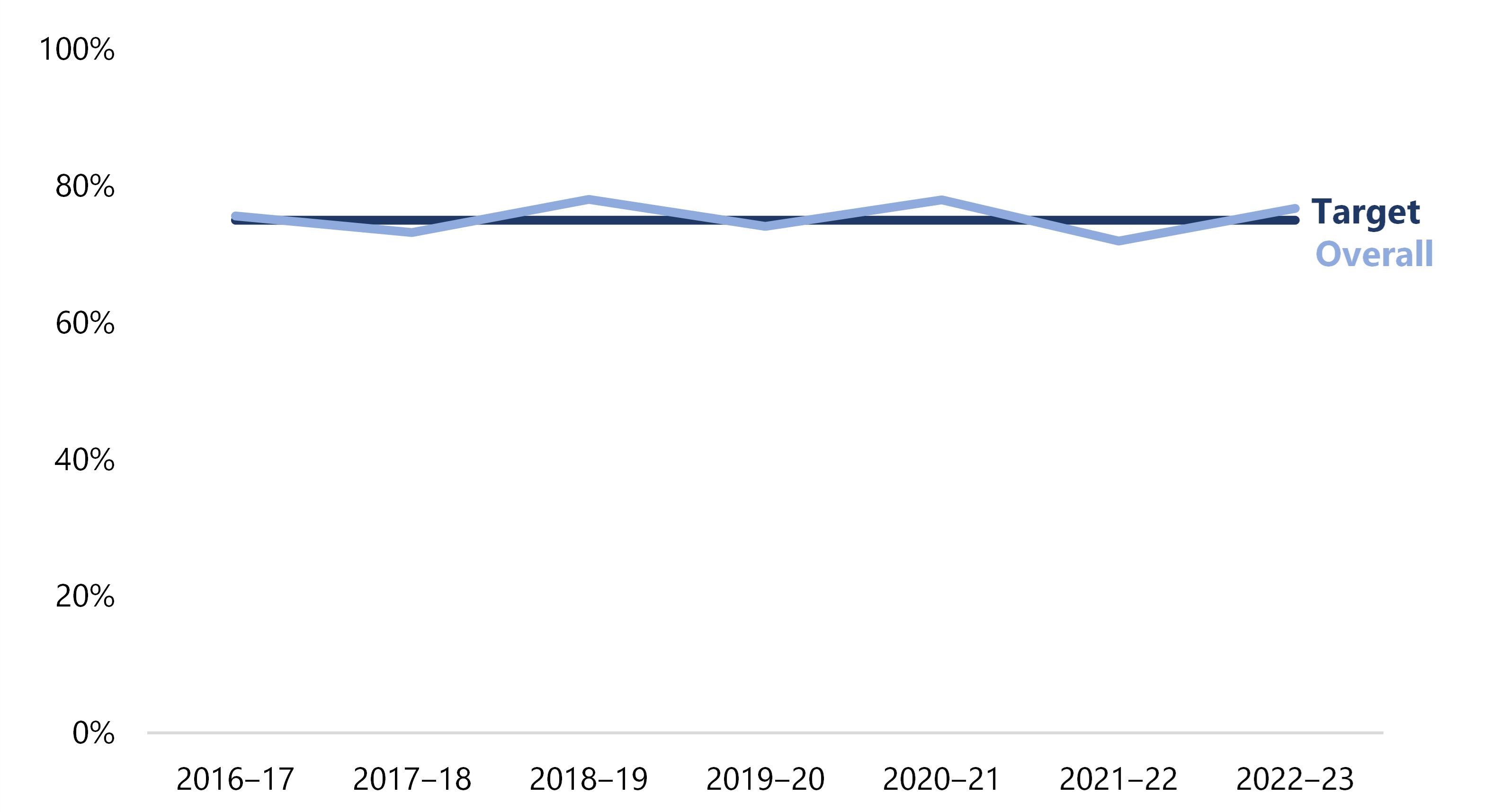
Source: VAGO.
Scores across the dimensions of process (80 per cent) and reporting (79 per cent) are both higher than 2021–22, exceeding our target of 75 per cent. Improvement could still be made on the level of satisfaction with the value of our work, with 72 per cent satisfaction compared with 68 per cent last year.
Satisfaction of performance auditees by dimension
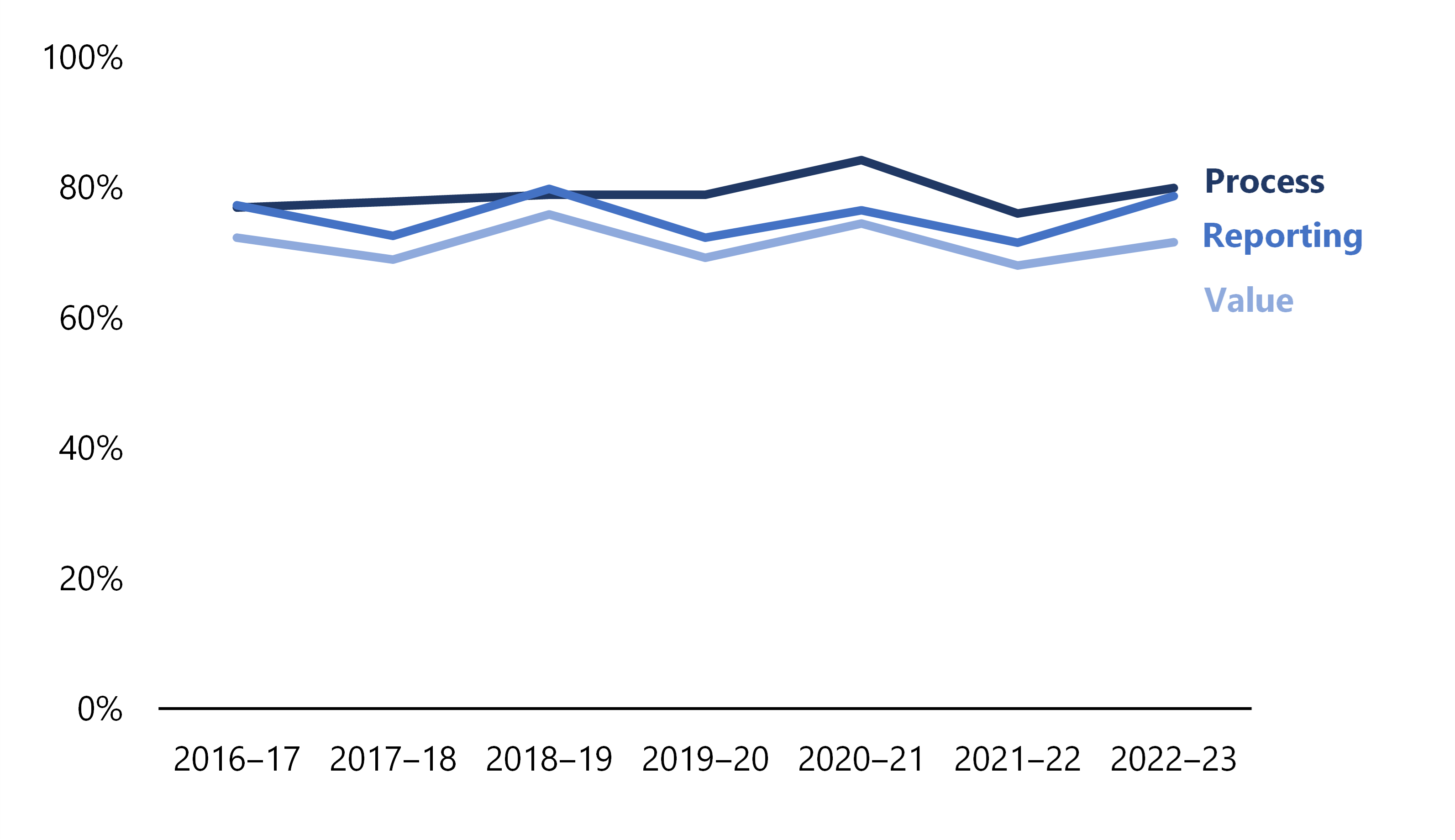
Source: VAGO.
Sourcing engagement topics from stakeholders
In developing our annual plan of engagement topics, we consult with the agencies we audit and a wide range of Victorian stakeholders.
To ensure our audit topics reflect issues of concern to parliamentarians and the public, our continuing aim is to increase the number of our audits originating from these sources.
This year, we received 175 requests and comments from the public and parliamentarians.
The correspondence comprised:
- 164 requests and comments from the general public
- 11 requests from parliamentarians.
Some of our 2023–24 planned audits relate to issues raised in these referrals, including:
- Delivering Victoria’s Big Housing Build
- Domestic building oversight part 1: regulation
- Domestic building oversight part 2: dispute resolution
- Withdrawal from Commonwealth Games 2026.
Increasing our engagement
Community health and aged care sector forum
In July 2022 we hosted a forum dedicated to our relatively new auditees in Victoria’s registered community health centre and aged care sector entities.
The forum was attended by the sector’s CFOs, CEOs, audit committee and board members.
Forums like this give us a better understanding of the auditee journey and allow us to build greater awareness and knowledge of our financial audit mandate.
Integrity Matters webinar
In November 2022 we joined IBAC and VO in the Integrity Matters webinar. The session reached more than 800 attendees, predominantly employees from the Victorian local government and public sector.
IBAC Commissioner The Honourable Robert Redlich AM, KC, Victorian Ombudsman Deborah Glass OBE and Victorian Auditor-General Andrew Greaves came together to discuss and share their collective experience and insights on matters of integrity and why integrity matters.
Institute of Internal Auditor’s Local Government Assurance Conference
In November 2022 we presented to the Institute of Internal Auditor’s Local Government Assurance Conference.
We shared:
- highlights from our Fraud Control Over Local Government Grants performance engagement
- highlights from our financial audits
- categorisation of all recent performance engagement recommendations, irrespective of which councils were involved in our audits.
Audit committee forums
Our audit committee chair forums are important events that allows chairs and members to network with their peers and learn more about sector-wide topics and areas of interest. These forums provide direct access to the Auditor-General, VAGO and topic experts.
This year, we held forums on 8 July 2022 and 18 November 2022.
Promoting greater transparency
Beyond our own work, we influence and shape how well the public sector reports its own performance, especially its outputs and outcomes.
We want to influence improved reporting by public organisations and the sector by encouraging open and transparent reporting with publicly accessible information that is reliable, meaningful and timely. We will:
- advocate for better financial and non-financial performance reporting through direct participation and engagement with industry and professional bodies
- build on our existing annual financial and non-financial data analytics dashboards, seeking to better integrate, unify and visualise our insights for each major sector.
Providing stronger advocacy
Joint paper with IBAC and the Victorian Ombudsman
In October 2022, we collaborated with IBAC and the Victorian Ombudsman to prepare and release a joint paper, Budget Independence for Victoria’s Independent Officers of Parliament.
We led the development of the paper, which discussed the current approach of other jurisdictions and set out a case to further strengthen the independence of Victoria’s key integrity agencies.
VPSC updates to officer and executive guide
Also in October 2022 the VPSC updated its officer and executive guide for informing and advising ministers.
As part of the VPSC’s release it acknowledged that much of the update was in response to our 2021 Implementing a New Infringements Management System performance engagement that recommended the Victorian Public Sector Commission in consultation with Department of Premier and Cabinet:
- strengthen leadership training and development to focus on, and facilitate conversations about, public servants’:
- role in providing advice to the government
- expectations for full and frank advice
- develop guidance for public servants on how to meaningfully engage with ministerial offices to appropriately convey risks and mitigation options for major projects and strategic activities.
Attending public sector forums and conferences
Our staff regularly attend and present at forums and conferences for professionals across sectors. We attended the following events:
- Victorian Local Governance Association Connect webinars
- FinPro conference presentations, regional meetings and question-and-answer panel sessions
- Chartered Accountants Australia and New Zealand: Finance Business Tech Conference and events
- Certified Practising Accountant Australia (CPA Australia): Public Sector and Not-for-profit Committee events
- CPA Australia: Virtual Congress
- Australasian Council of Auditors General (ACAG): committees, events and webinars
- Departmental CFO forums and industry forums.
Professional and peer organisations
Throughout the year we engaged with our peers from other audit offices through ACAG. We were involved in role-based subgroups focused on promoting and strengthening public sector auditing, including:
- Heads of Performance Audit (HOPA)
- Heads of Financial Audit (HOFA)
- Data Analytics
- Systems Assurance
- Financial Reporting and Advisory Committee (FRAC)
- Corporate Services.
We also engaged with the:
- Australian Accounting Standards Board
- Australian Auditing and Assurance Standards Board.
3. Better public services
The second goal in our 2022–25 strategic plan is better public services for Victorians.
This section details our work towards achieving that goal.
Working to improve public services for Victorians
Realising our goal of better public services for Victorians involves:
- making better use of our financial and non-financial data
- improving our engagement and entity-level reporting.
These objectives are underpinned by our ability to deliver our services effectively and efficiently, including leveraging our information for greatest benefit.
Our financial auditing services
All public sector agencies publish an annual report, which must include their financial and performance information. To do this, their financial reports and (where applicable) performance statements must be independently audited.
Our financial audits provide independent assurance to Parliament and the public that the information contained in a public sector entity’s financial report is reliable, relevant and fair.
Scope and focus of our financial engagements
Our sector-based approach
Our financial auditing division is organised by sector.
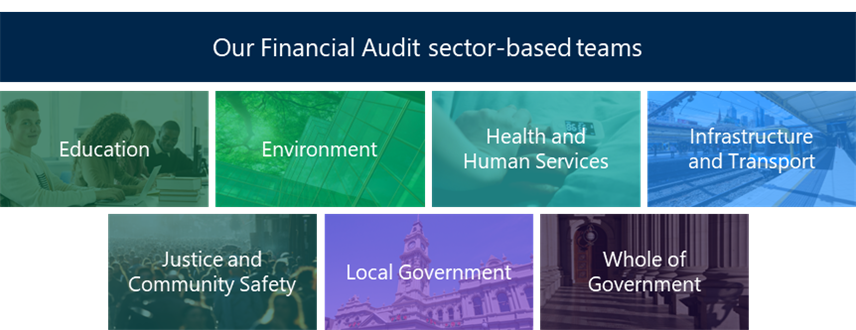
Financial auditing services in 2022–23
Audit opinions issued
We issued 547 audit opinions on financial reports prepared by 501 agencies. We carried over 7 of these opinions from previous reporting periods.
We also issued 109 audit opinions on the performance statements of local councils, water agencies and TAFEs, and 120 acquittals for local councils and departments.
Parliamentary reporting on financial audits
Under the Act, we must report to Parliament the results of our audit of the state’s financial report, which is prepared by the Treasurer.
We also report separately on the results of our audits for:
- local governments
- TAFEs
- universities.
Although not mandatory, the size and impact of these sectors make more detailed reporting a valuable tool for Parliament and the community.
Financial audit reports tabled in 2022–23
| Status | ||||||||
|---|---|---|---|---|---|---|---|---|
| Category | Report | For financial period | Tabled | In progress | Planned | |||
| Whole of government | Auditor-General’s Report on the Annual Financial Report of the State of Victoria: 2021–22 | 2021–22 | ⬤ | |||||
| Local government | Results of 2021–22 Audits: Local Government | 2021–22 | ⬤ | |||||
| Education | Results of 2021 Audits: Technical and Further Education Institutes | 2021 | ⬤ | |||||
| Results of 2021 Audits: Universities | 2021 | ⬤ | ||||||
| Results of 2022 Audits: Technical and Further Education Institutes | 2022 | ⬤ | ||||||
| Results of 2022 Audits: Universities | 2022 | ⬤ | ||||||
| ⬤ | As planned | ⬤ | Delayed | |||||
Note: Results of 2021 Audits: Technical and Further Education Institutes and Results of 2021 Audits: Universities delayed from 2021–22 and tabled in July 2022.
Listening to our stakeholders
Survey of audited agencies (financial audits)
We survey clients to better understand how we are performing.
We received 250 responses across two rounds to our survey of audited agencies for financial audits this year, relating to their 2021-22 audits.
We explore how satisfied they are with our people, and whether our auditors:
- conducted themselves professionally during the audit
- had the right professional skills and knowledge
- demonstrated an adequate understanding of their organisation.
Financial auditees’ average satisfaction with our people
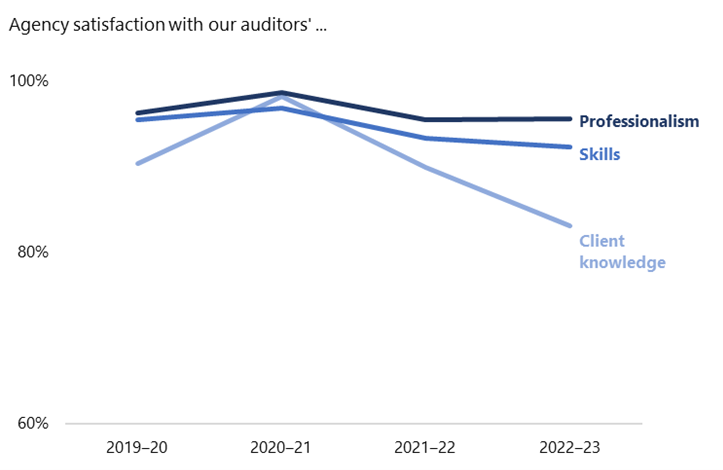
Source: VAGO.
We explore how satisfied our clients are with our outputs, and whether:
- they value our recommendations to improve the financial management and internal controls of their organisation
- they value the assurance obtained from the audit of statutory financial statements
- our management letters were balanced and fair
- our management letters clearly communicated audit findings and issues.
Financial auditees average satisfaction with our outputs
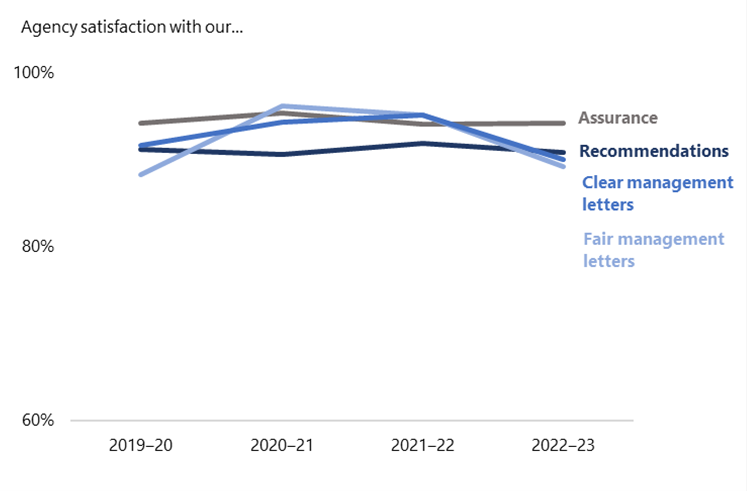
Source: VAGO
We were challenged last year by an elevated turnover of financial audit staff post-COVID-19, and we needed to use an expanded contingent workforce to deliver our audits within the shortened timeframes in the lead-up to the last state election. This led to a lack of continuity of audit staff on a number of audits, which affected our clients' views of our understanding of their operations.
We will improve these outcomes by rebalancing our workload and improving the employee experience through learning and development and retention strategies.
Leveraging our data and expanding our contribution
Our ongoing presence in every public sector entity enables us to build a store of knowledge – tacit and explicit – about how the sector works and how it can be improved.
We continue to provide insights into ‘what good looks like’. We continue to assess how we can better extract value from our growing datasets to produce new insights.
Sharing our data insights
Transparent service performance
As part of our strategy to reform and enhance the reporting of service performance by the public sector, we again published a service performance data analytics dashboard on our website as part of our yearly audits on measuring and reporting on service delivery.
This dashboard allows users to:
- compare departmental performance
- drill down to examine performance trends for individual measures
- download raw data on output performance measures and conduct their own analysis.
We also publish a data analytics dashboard on our annual report webpage. This complements the audited performance statement in our annual report and provides a visual representation of our performance.
Sharing our public datasets
Where possible, we also share our public datasets to assist government sectors and industry associations further their advocacy work.
An example is the published financial data of local governments we shared with the Municipal Association of Victoria.
Drawing on our financial data and expertise
Engaging with the public sector
This year, our Financial Reporting Advisory (FRA) team published one financial reporting alert on 3 February 2023.
Significant accounting developments covered:
- key accounting and other developments relevant to 2022–23 financial statements
- Australian Accounting Standards Board (AASB) post-implementation reviews (PIRs): ITC 49, 50 and 51.
Content included a summary of significant amendments and the likely impact for affected Victorian public sector entities.
By sharing knowledge in this way, we aim to create awareness in the Victorian public sector, helping agencies respond to financial reporting developments in a timely fashion.
Engaging with the Australian Accounting Standards Board
The FRA team continue to engage regularly with the AASB to discuss how accounting standards are applied in the public sector.
Team members attended staff liaison meetings, provided feedback on AASB consultation documents, and participated in AASB project advisory panels (including the Fair Value project advisory panel and Not for Profit project advisory panel).
Engaging with the Australian Auditing and Assurance Standards Board
Our Audit Quality (AQ) team continue to engage with the Auditing and Assurance Standards Board (AUASB) to discuss auditing standards and potential implementation issues in the public sector.
The team gave feedback to the AUASB on the guidance standard GS23 Special Considerations – Public Sector Engagements. The team also provides feedback to the AUASB on other projects via ACAG and the project advisory group network.
Engaging with the Department of Treasury and Finance
This year, FRA continued to work closely with the accounting policy team at the Department of Treasury and Finance (DTF) on technical accounting matters.
Our FRA Director presented at the DTF a workshop, ‘What’s new for 30 June 2023 year-end reporting’, for senior financial reporting personnel within the public sector involved in the preparation of departmental and agency annual reports.
Improving entity-level reporting and leveraging performance data
Dashboards and data visualisation
Our data analytics dashboards create better impact than static tables. We continue to receive positive feedback from our stakeholders and the community.
Dashboards published in 2022–23
| Topic | Posted |
|---|---|
| Results of 2021 Audits: Universities | July 2022 |
| Results of 2021 Audits: Technical and Further Education Institutes | July 2022 |
| Fair presentation of service delivery performance 2022 | September 2022 |
| Annual Report 2021–22 | September 2022 |
| Major Projects Performance | September 2022 |
| Auditor-General's Report on the Annual Financial Report of the State of Victoria: 2021–22 | October 2022 |
| Results of 2021–22 Audits: Local Government | February 2023 |
| Departments’ reported consultant spend: 2017–18 to 2021–22* | June 2023 |
| Reporting on Local Government Performance** | June 2023 |
| Results of 2022 Audits: Universities | June 2023 |
| Results of 2022 Audits: Technical and Further Education Institutes | June 2023 |
Notes:
* Companion product for Contractors and consultants in the Victorian public service: spending audit, which we will table in 2023.
** Uses data submitted by councils under the Local Government Performance Reporting Framework and published by Local Government Victoria (LGV).
Source: VAGO.
Examples of high-impact dashboards
By bringing together information from multiple sources, we can make publicly available information more accessible and meaningful to members of parliament and the public.
Our work can make information that is sometimes difficult to find and compare more accessible.
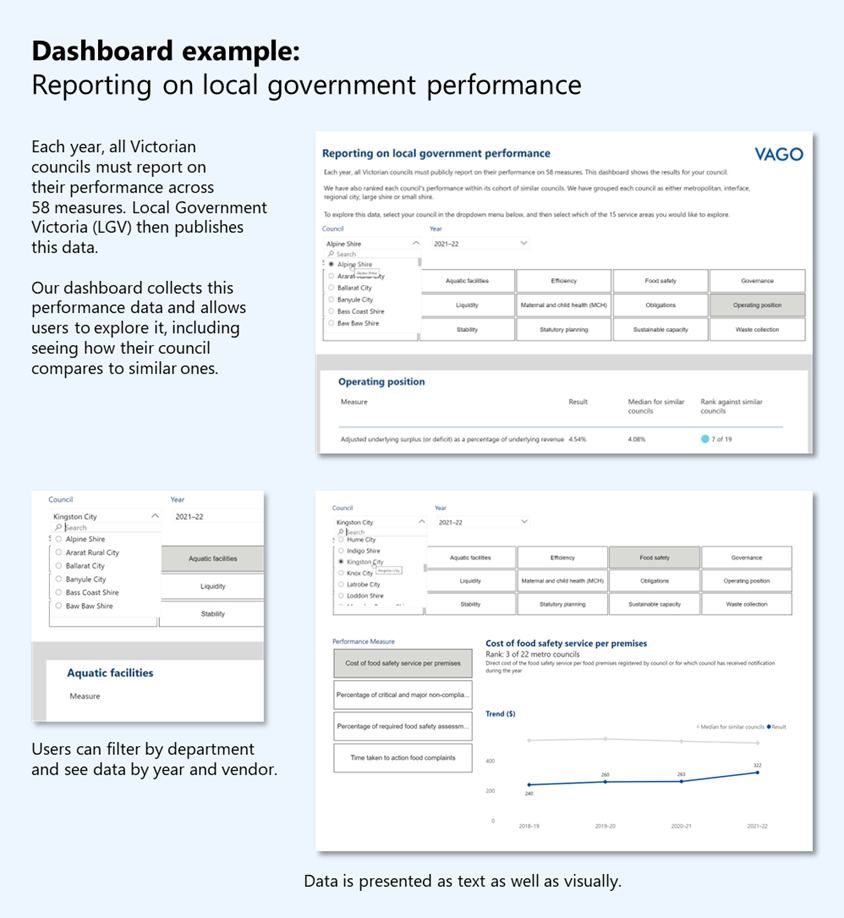
www.audit.vic.gov.au/dashboards/reporting-local-government-performance
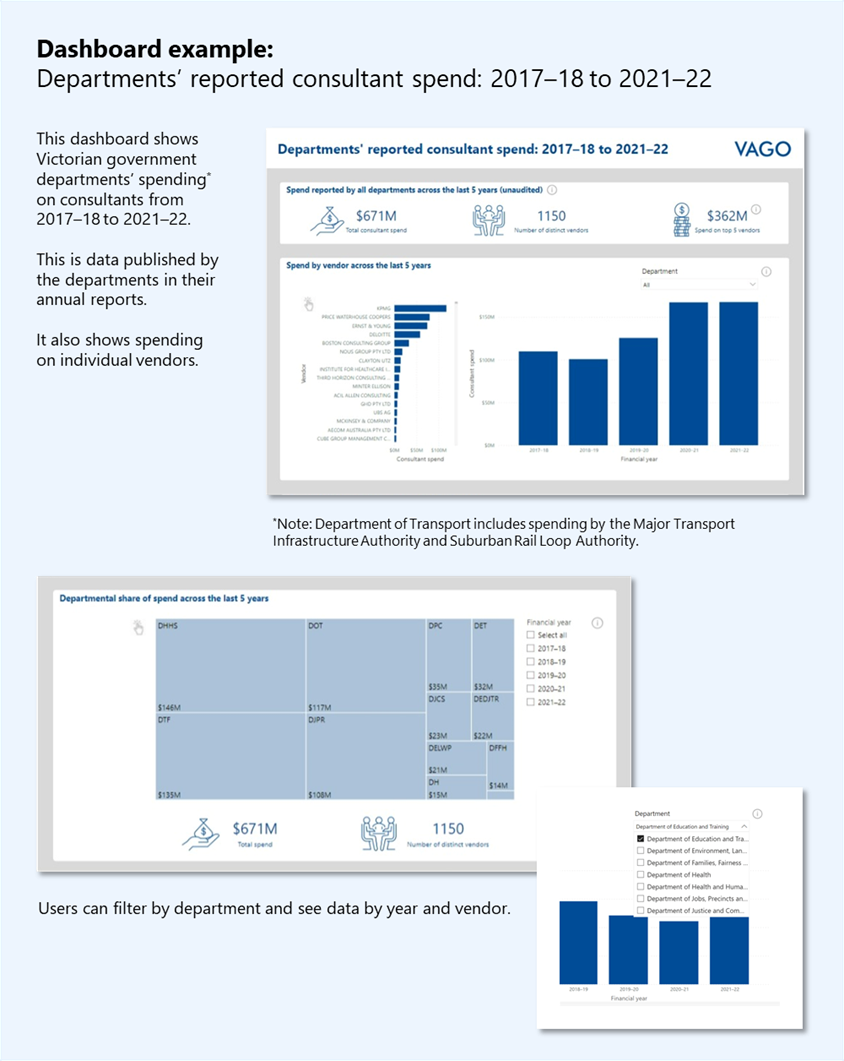
www.audit.vic.gov.au/dashboards/departments-reported-consultant-spend-2017-18-2021-22
Our impact on agencies
In addition to measuring auditees’ satisfaction, we also track their progress in responding to our work.
Agency responses to our recommendations
Agency responses for performance engagements
Our performance engagements identify opportunities for public agencies to improve how they work. We do this by uncovering risks, weaknesses and poor performance, as well as by sharing examples of better practice. We then make recommendations to agencies to address areas for improvement.
We conduct an annual review to monitor how the agencies we audit address our findings. This makes agencies’ responses to our recommendations more transparent to Parliament and the community.
|
In … |
We examined … |
Of which … |
We found that agencies had … |
|---|---|---|---|
|
2022* |
all 1,316 recommendations made in July 2018 – December 2021 |
|
completed 66 per cent of recommendations they accepted, taking a median of 11 months. |
|
2023* |
all 1,518 recommendations made in July 2018 – June 2022 |
|
completed 79 per cent of recommendations, taking a median of 12 months. |
*Year report tabled.
We tabled our 2023 annual status update on 30 August 2023.
Measuring completion
We measure the percentage of accepted performance audit recommendations that agencies report as completed across a 2-year period.
The 2022–23 result of 77 per cent remained slightly below our target.
Results of our review of outstanding performance audit recommendations
| Criteria | 2022–23 result | Prior year result | Target |
|---|---|---|---|
| Total recommendations under review | 1,518 | ||
| Recommendations tabled in 2019–20 and 2020–21 | 597 | ||
| Number of those tabled recommendations accepted fully, in part or in principle | 559 | ||
| Number of those accepted (fully, in part, or in principle) recommendations reported as complete | 429 | ||
| Overall result Accepted performance audit recommendations the audited agencies reported as completed across a 2-year period. |
77% | 78% | 80% |
Source: VAGO.
Completion by agency
As part of our review, we look at the completion rate for individual agencies.
Agencies continue to complete actions in response to our recommendations. The median time taken to complete a recommendation after the audit tabled was 12 months.
Median number of months to complete a recommendation, by department
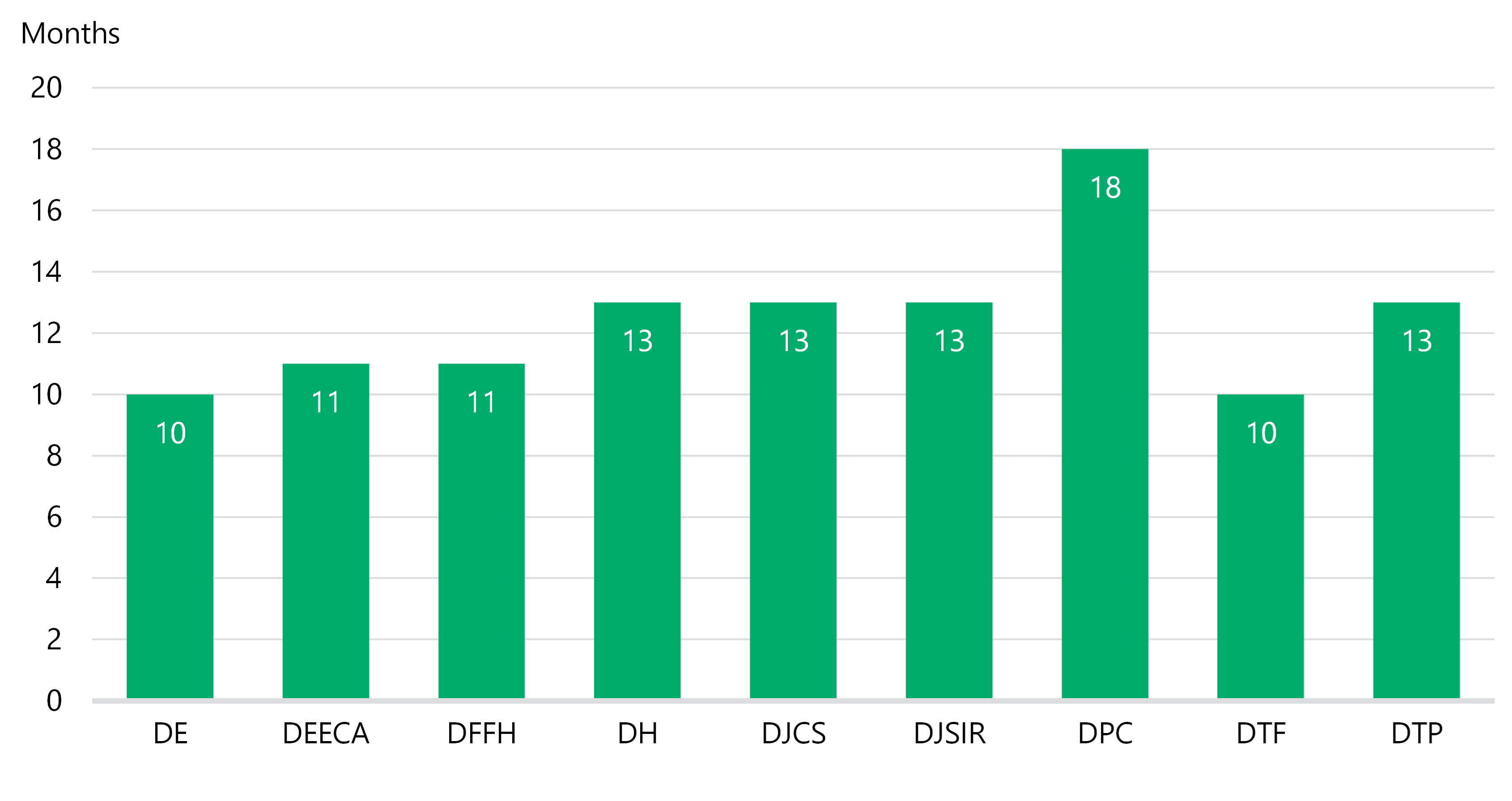
Notes: The Department of Government Services (DGS), established on 1 January 2023, is excluded. Acronyms used are for the Department of Education (DE), Department of Energy, Environment and Climate Action (DEECA), Department of Families, Fairness and Housing (DFFH), Department of Health (DH), Department of Justice and Community Safety (DJCS), Department of Jobs, Skills, Industry and Regions (DJSIR), Department of Premier and Cabinet (DPC), Department of Treasury and Finance (DTF), Department of Transport and Planning (DTP).
Source: VAGO.
Agency responses for financial audit
Our financial audits continue to make a measurable impact on internal controls.
We issue management letters to agencies:
- highlighting issues related to internal control weakness and other matters we find
- making recommendations to resolve these issues.
Agencies respond to these letters with their intended actions.
Percentage of issues raised by financial audit that have been resolved
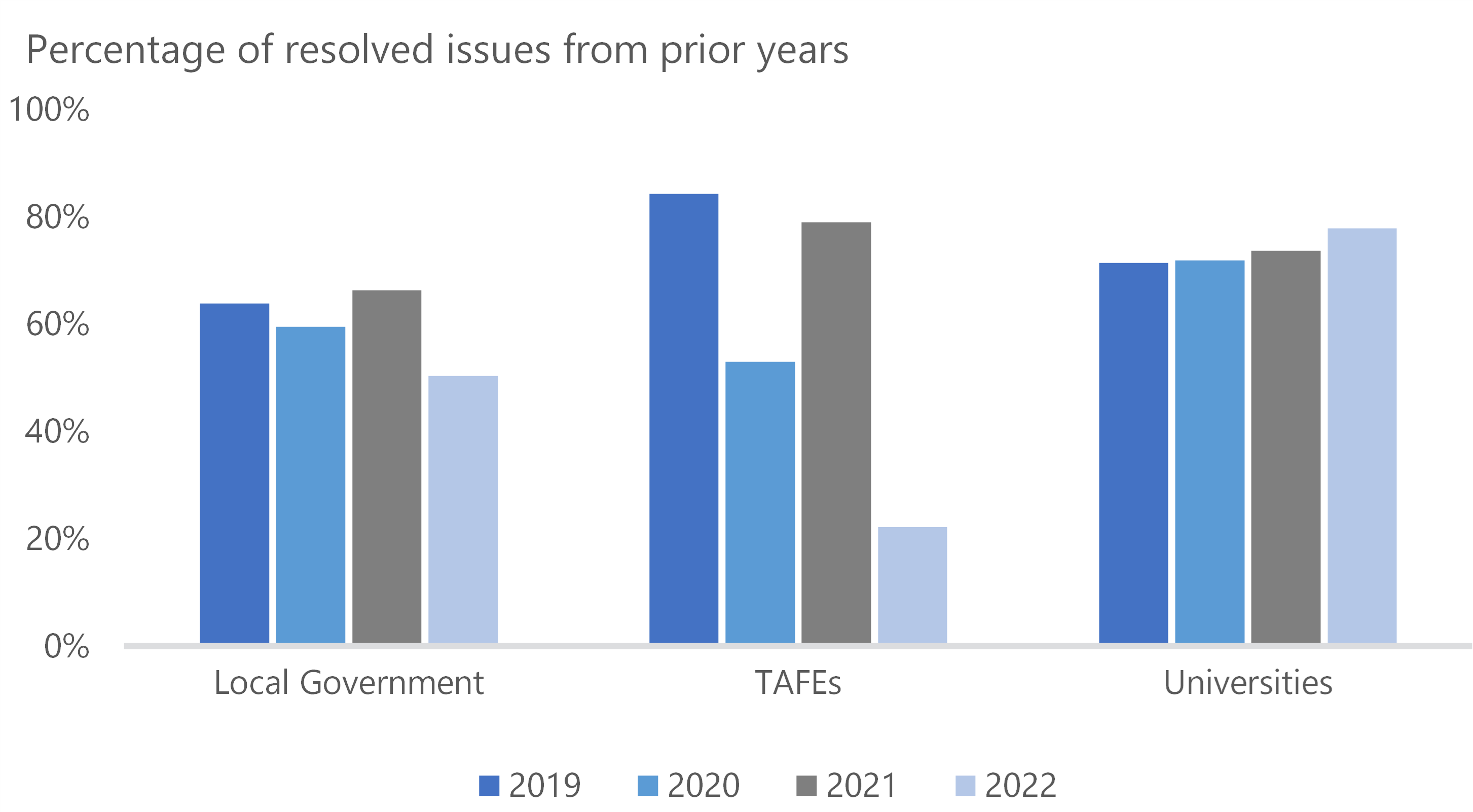
Source: VAGO.
Delivering our services efficiently and effectively
As we continue to focus on realising our strategic goals of better public services and a transparent and accountable public sector, we must also deliver our own services efficiently and effectively.
We set ourselves high expectations. We strive to model what we audit: effectiveness, efficiency and economy, compliance with standards and legislation, and reliability.
Service delivery in 2022–23
Overview
Every year, we report against a set of performance measures and targets that we agree with the Assistant Treasurer. We report these measures and targets in our performance statement in this report. In addition, we also report our performance against cost and time measures.
Parliamentary reports and services
Average cost of our parliamentary reports
The average cost of our parliamentary reports in 2022–23 was $438,360.
This is less than the 2021–22 average ($683,636), and 18.1 per cent less than our 2022–23 target ($535,400).
The lower average cost of our reports reflects the actual mix of audit engagements that we delivered, primarily in terms of scope and timeliness. This year, we tabled 2 additional results of financial audit reports from last year due to delays resulting from the pandemic. We also tabled 4 assurance reviews, both of which cost significantly less than the average.
Our performance statement details our performance measures further.
Delivering performance audit reports
This year our average time to complete performance audits (from initiation to tabling) was 10.1 months.
This is 3.2 months less than last year and 1.1 month more than our target of 9 months.
The average time to table our reports increased during the pandemic due to staff turnover, unplanned leave and client delays in providing information or responses to our draft reports. Reduced disruption since the pandemic, and improved project management in 2022–23, brought our result significantly closer to our target.
Delivering financial audit reports
The average time to produce our parliamentary reports on results of our financial audits after the balance date in 2022–23 was 6 months.
This is above our result last year and above our target of 5 months.
We tabled 6 financial audit parliamentary reports during 2022–23, 2 of which we carried over from 2021–22 and tabled in early-July 2022:
- 1. Results of 2021 Audits: Technical and Further Education Institutes
Delivered over target at 6.2 months. - 2. Results of 2021 Audits: Universities
Delivered over target at 6.2 months. - 3. Auditor-General’s Report on the Annual Financial Report of the State of Victoria: 2021–22
Delivered within 3.9 months and within our target of 5 months as required by the Act. - 4. Results of 2021–22 Audits: Local Government
Delivered over target at 7.8 months. - 5. Results of 2022 Audits: Technical and Further Education Institutes
Delivered over target at 5.9 months. - 6. Results of 2022 Audits: Universities
Delivered over target at 5.9 months.
Audit opinions on financial reports and performance statements
Average cost and timely delivery of audit opinions
The public sector agencies we audit pay us for the financial audit work we perform.
The Act allows us to recover reasonable costs only, so it is important that we continuously monitor and benchmark our service costs.
The average cost of the audit opinions we issued on financial statements during 2022–23 was $55,189, above both our 2021–22 result and our target.
Average cost to deliver audit opinions in 2022–23
| Financial service | 2022–23 average | Prior year average | Target average |
|---|---|---|---|
| Audit opinions on financial statements | $55,189 | $54,319 | $50,800 |
| Audit opinions on performance statements | $5,395 | $5,200 | $5,500 |
| Audit opinions issued within statutory deadline | 97.2% | 96% | 98% |
| Management letter to agencies within agreed timeframes | 90.7% | 90% | 90% |
Source: VAGO.
Delivering audit opinions
The average cost of audit opinions for both financial reports and performance statements again exceeds our target, which is capped by the Australian Bureau of Statistics Wage Index. Actual costs to complete audit opinions were above the index because we:
- experienced challenges with competitive labour market conditions and staff availability across the accounting industry, increasing internal staff costs and that of our audit service providers
- engaged a contingent workforce to help get our audit delivery back on track post-pandemic
- responded to the introduction of the updates to the Auditing Standard ASA 315 Identifying and Assessing the Risks of Material Misstatement, which required us to reconsider our knowledge and risk assessment of IT systems for all our audit clients, and used additional staff and outsourced IT expertise.
Meeting statutory timeframes
Agencies have statutory timeframes in which to complete their annual financial reports, and table their annual reports. This means our work must be timely.
Although we missed our target for issuing audit opinions, we met our target for final management letters, and our performance improved on our prior-year results.
Elevating our audit methods and tools
Performance auditing
Enhancing performance audit through data science
Performance audits are bespoke and qualitative, presenting unique opportunities for data analytics. We have therefore integrated the use of data analytics into our performance audit methodology.
We aim to perform annual planning supported by data analytics for annual planning, and to increase the data analytics capability of our staff.
While this opportunity will take time to realise, embedding data scientists within performance audit teams is already making an impact—on the way we plan for, gather and analyse evidence, and on the way we communicate our findings.
We see the impact of the data science team’s work in our engagement statistics, such as the data analytics dashboards on our website. It has also been gratifying to be recognised by our peer audit offices, winning the Australasian Council of Auditors-General (ACAG) Innovation Award for the third year in a row:
- 2023: Received Innovation Award for analytics on Police Body Worn Cameras audit
- 2022: Received Innovation Award for Major Projects Performance data analytics dashboard
- 2021: Received Innovation Award for Accessibility of Tram Services audit.
Engagements with data science input
These examples from our 2022–23 program demonstrate how our data scientists drive outcomes on performance engagements.
|
Data scientists worked in our performance engagements on … |
To … |
|---|---|
|
quality of child protection data |
assess data quality issues affecting records of children in care |
|
regulating native forests |
develop a geosptatial analysis of compliance with land-clearing regulations |
|
services for alcohol and other drugs |
assess data quality controls and systems used for data collection |
|
maintaining metropolitan railway infrastructure |
assess data quality, the completion and timeliness of metropolitan railway infrastructure maintenance |
|
supporting sexual and reproductive health |
analyse customer relationship management including demand and supply of services |
|
school principal health and wellbeing |
analyse personnel data including provision of wellbeing services, absences and compensation claims data |
|
cybersecurity in the Victorian Public Service |
provide internal subject matter advice on cybersecurity in the context of modern information technology |
|
local government performance dashboard |
produce a data analytics dashboard that allows members of the public to explore data on local government performance |
|
use of consultants in the Victorian Public Service |
develop a data analytics dashboard for the public on the use of consultants in the Victorian Public Service |
Audit solutions and toolsets
In 2023 we performed a post-implementation review of our strategic audit planning process. We will implement actions resulting from our review as part of an update to our performance audit methodology. This update aims to:
- further integrate strategic audit planning into our performance engagements
- streamline our performance methods and approaches to focus on the key areas of risk and materiality
- replace our legacy audit toolsets with cloud-based solutions that facilitate more efficient and effective audits and reviews.
We will progressively implement these updates during 2023–24.
Financial auditing
Empowering financial auditors with data analytics
We used Empower, our in-house data analytics platform, to support financial audits for 53 clients. We developed 96 data analytics dashboards, which we updated periodically for our auditors.
The benefits of these dashboards include:
- providing our auditors with source data
- assisting with planning analytics
- assisting with sampling
- enabling auditors to run computer-assisted audit techniques over data
- assisting with more traditional substantive testing, such as fully recalculating material classes of revenue.
Our EPIC financial audit methodology
We continue to refine our Engage, Plan, Implement and Conclude (EPIC) methodology, and develop training and guidance to support our auditors.
We are well progressed with a project to replace our existing legacy audit toolset with a modern solution. Our project team has evaluated the market and is currently working with a single vendor on a potential replacement toolset.
4. Our office and people
To be successful we need to empower our people and enrich their working experience.
We are committed to facilitating individual professional development and supporting teams with high quality systems and methodologies.
A values-driven organisation
The third pillar of our strategic plan is an enriched experience for our people.
Our people are at the heart of what we do, and we are committed to facilitating their professional development. We also support them with high-quality systems and methodologies.
Our values are accountability, collaboration, innovation and respect. These values shape our work, our culture and how we grow as an organisation. In 2022–23, we continued to promote and embed these values through team-building activities and by celebrating the outstanding efforts of our employees both day to day and more formally at recognition events.
Outcomes and achievements in 2022–23
This section sets out the last year’s initiatives, achievements and outcomes organised by our four values. This demonstrates our ongoing leadership commitment as a values-driven organisation.

We empower others. We meet agreed commitments. We are responsible for, and transparent about, decisions and actions. We make decisions that withstand scrutiny.
Demonstrating accountability in all we do
In this section
Audit quality systems, models and methodologies
Updating audit quality management systems
Effective 15 December 2022 the AUASB released its new quality standards:
- ASQM1 Quality Management for Firms that Perform Audits or Review of Financial Reports and Other Financial Information, or Other Assurance or Related Services Engagements
- ASQM2 Engagement Quality Reviews
- ASA 220 Quality Management for an Audit of a Financial Report and Other Historical Financial Information.
Responding to these new requirements, we developed a framework for our system of quality management (SQM) underpinned by an assessment of audit quality objectives and risks. The SQM comprises our policies and procedures that we designed and implemented to mitigate quality risks. The launch of our SQM will occur in the fourth quarter of 2023, along with SQM awareness training for all staff. We will undertake an annual evaluation of our SQM and report the results of the evaluation in our next transparency report.
Capability framework
Enhancing financial audit capability
In response to extensive staff consultation on the current employee experience, we know that our financial auditors want:
- opportunities to learn, develop and grow
- a well-designed capability framework
- an aligned learning and development curriculum
- clear succession pathways.
This year we commenced the Enhancing FA’s Capability project that will deliver a new structured capability framework, with a supporting learning and development curriculum and succession pathway. We have prepared a draft framework and transitional plan, and we expect to launch it next year.
Risk management and security
Zero-trust security
This year we continued our investment in strong and secure IT systems, adopting a zero-trust plan, based on Microsoft’s zero-trust security model. Zero trust is a modern security strategy based on the principle: never trust, always verify.
Key features of our plan include:
- identity and access management
- device trust
- conditional access policies
- data protection
- threat protection
- analytics and monitoring
- information governance.
This plan further mitigates the risk of unauthorised access and data breaches.
Gender pay gap
Results
This year, our gender pay gap was 3 per cent in favour of men, compared to 0.3 per cent in 2021–22.
As of 30 June 2023, 59 per cent of our workforce identified as women, with:
- 115 women
- 77 men
- 2 self-described
- 2 who preferred not to say.
The calculation includes all employees and employee types (part-time and casuals included) who identify as male and female but does not include those identifying as non-binary or self-described. This reflects our reporting obligations to the Workplace Gender Equality Agency (WGEA).
Women as a proportion of part-time workers and executive
This year, the proportion of executive roles filled by women dropped slightly.
The proportion of part-time workers represented by women did not change in 2022–23. However, the proportional shift since before the pandemic indicates that more people are taking advantage of flexible working arrangements.
Proportion of part-time workers and executive roles held by women
| 2022–23 | 2021–22 | 2020–21 | 2019–20 | |
|---|---|---|---|---|
| Part-time workers | 82% | 82% | 90% | 100% |
| Executive roles | 42% | 46% | 44% | 42% |
Source: VAGO.
In 2022–23, the VPSC changed the definition of ‘executive’ to exclude substantive Victorian Public Service (VPS) staff acting in executive roles, who were counted as executives in previous years.
Comparison with national and Victorian results
While there is room for us to improve, our gender pay gap is significantly lower than the:
- national gap, which is 13.3 per cent
- Victorian gap, which is 13.4 per cent.
Source: Workplace Gender Equality Agency based on ABS survey data, February 2023.
Broadening our pay gap reporting
In the past, we have routinely calculated our gender pay gap using the mean (average) salaries of men and women. However, in 2022–23, we also assessed the pay gap via their median (middle) salaries.
We introduced this extra calculation ahead of changes in our reporting obligations to WGEA for the 2023–24 reporting year.
Going forward, WGEA will require employers to report their median gender pay gap and CEO salaries (which would typically skew the mean gender pay gap). The median pay gap is less influenced by staff who have high or low salaries, so gives a better indication of the pay gap for most of our small workforce.
For more information about our workforce profile (including gender, age ranges, VPS classification) and the gender pay gap at VAGO, see Appendix A.
Gender Equality Action Plan 2022–25
Our Gender Equality Action Plan 2022–25 outlines a range of strategies we are implementing as part of our journey towards full gender equality.
In accordance with the Gender Equality Act 2020, we will prepare a report of our progress for the Victorian Commission for Gender Equality in the Public Sector in 2024.
Our plan is available at www.audit.vic.gov.au/corporate-publications.
Workforce productivity and outcomes
How we measure workforce production
We measure our workforce production as the total percentage of available paid staff hours that are charged to our 3 outputs:
- parliamentary reports and services
- audit opinions on financial and performance statements
- audit support services.
Staff are able to monitor their contribution to production targets and that of their direct reports using real-time data analytics dashboards.
Overall production effort
Our overall production effort this year was 54.5 per cent, slightly lower than our 2021–22 result of 55.4 per cent and our target of 60 per cent. We attribute this mostly to a lower-than-budgeted staff full-time equivalent (FTE) in our Performance Audit division.

We work well with colleagues and demonstrate support and trust. We learn and develop, and give constructive feedback. We share knowledge and insights.
Working collaboratively to enrich experiences and improve outcomes
In this section
This section includes updates on the following:
- Embedding Better Normal in our workplace
- Knowledge sharing
- Professional collaborations
- Our office community
Embedding Better Normal in our workplace
Promoting flexibility and work–life balance
To be an employer of choice, we need to provide our staff the most contemporary work practices possible. Work flexibility is central to achieving this.
To guide this, we designed and introduced our Better Normal principles in 2021. These do not prevent us from working ‘together, together’ with our peers, teams, or clients.
We come together when we believe being in-person will provide high-impact and high-value collaboration. This may include audit work, learning and development, team-building experiences or managing client-related matters.
In line with our Better Normal principles, we consider team preferences, value, impact and business needs when deciding how and when we connect with each other.
Synchronous and asynchronous working modes
Our Better Normal principles are inspired by Gartner’s 'Intentional collaboration in a hybrid world' model.
They encompass 4 modes of working, balancing high-value engagement with opportunities for deep focus.
The 4 modes of working
Source: VAGO, based on work published by Gartner.
Supplying home office equipment
Most of our staff choose to work from home for at least some of the time.
To support this, while ensuring their comfort, safety and best working experience, we continue to supply all team members with a sit–stand desk, ergonomic chair, monitors and other equipment such as laptop risers and chair mats.
Staff can also choose to work from our office at 35 Collins Street, Melbourne.
Software for virtual workshops
We delivered several IT initiatives this year that supported effective, efficient, secure and collaborative work practices. For example, we implemented a collaborative platform to optimise virtual workshops.
Our teams are now better able to collaborate through mindmapping, project planning, and storyboarding online.
Knowledge sharing
Data and Analytics (DASA)
The Data Analytics and Systems Assurance (DASA) team is responsible for our Empower software, a product that allows our financial auditors to leverage information and improve audit quality and efficiency.
DASA provides formal and informal training, coaching and weekly ‘tips and tricks’ posts, which help our auditors embed digital knowledge in their work.
Lunch ‘n’ Learn sessions
Our regular Lunch ‘n’ Learn sessions supplement formal training offerings. Our more experienced staff share their knowledge and experience, lifting their colleagues’ practical skills and capabilities.
Topics included audit appropriations and performance reporting, understanding audit toolsets, and strategic writing skills.
Live-streamed briefings and catch-ups
Each fortnight we come together for a stand-up briefing hosted by one of the 4 members of our Strategic Management Group. We record these events for those unable to attend the live event.
Professional collaboration
Maintaining professional networks
We support staff to attend industry conferences to maintain professional networks and currency in their profession.
This year a delegation of 11 staff attended the International Meeting of Performance Audit Critical Thinkers (IMPACT 2023) conference hosted by the Australian National Audit Office in Canberra.

Pacific Association of Supreme Audit Institutions: www.pasai.org
Our office community
Assistance animal in the office
 In 2022 staff in our Collins St office enjoyed the company of a 4-legged friend named Gunner, a Guide-Dog-in-training.
In 2022 staff in our Collins St office enjoyed the company of a 4-legged friend named Gunner, a Guide-Dog-in-training.
Our office gave Gunner the chance to learn to be calm and relaxed in a work environment, recognise obstacles, cross busy roads, move through large crowds with ease and board public transport .We were proud to hear he had passed his official assessment and has since been matched with someone special to provide them with confidence, companionship and greater independence.
Fundraising
The VAGO Social Club ran events and campaigns throughout this year to encourage our people to donate to charities, including:
- CARE Australia Pakistan Flood Relief Appeal, to support those in Pakistan impacted by floods
- Breast Cancer Network Australia
- World’s Greatest Shave to help beat blood cancer
- Fight Cancer Foundation.

We harness ideas to adapt and evolve. We have the courage to take informed risks and challenge the status quo. We embrace lessons from the new things we try.
Making innovation part of business as usual
In this section
This section includes updates on the following:
- Continuous improvement through internal audit
- Enhancing our financial audit capability uplift
- Professional development
Continuous improvement through internal audit
Internal audit
We delivered another 5 internal audit reviews this year. Our internal audit program examines operational internal control systems, including administrative and financial information systems, to evaluate the extent that:
- information is accurate and reliable
- internal policies and external laws and regulations are followed
- resources are employed efficiently and effectively
- financial assets and information are safeguarded.
Reviews completed this year were:
- ERP System Implementation Phase 2
- ASP management and supervision
- risk management framework review
- financial management compliance framework
- management reporting effectiveness.
Internal audit recommendation ratings, 2022–23
| Recommendations rating | 2022–23 |
|---|---|
| High | 0 |
| Moderate | 10 |
| Low | 7 |
| Opportunity | 1 |
| Total recommendations | 18 |
Enhancing our financial audit capability
Financial audit technical training
Our Financial Reporting Advisory (FRA) team and Audit Quality (AQ) team conducted a 2-day training program in November 2022 for all financial audit staff. Its purpose was to enhance the technical knowledge and awareness of changes to the auditing standards to support staff in performing technically compliant audits and improve audit quality.
The FRA and AQ teams conducted this training face to face and all financial auditors collaborated on scenario-based case studies to reinforce the concepts learnt.
This training also covered the public sector framework to help new starters understand the strategic context.
Professional development
Data literacy
We continued to focus on data literacy this year. Staff led projects to lift capability in data visualisation and communication, and data engineering.
One project delivered was the data visualisation ‘book club’, which fostered a culture of storytelling with data. Our Dataviz Champions developed eLearning modules on how to use data to tell a story for our target audience. Our new infographic library is important for supporting staff to present complex data visually.
Staff also stretched their data science skills in 2022–23, creating and implementing a comprehensive global audit database. This centralises audit findings and best practices to facilitate informed decision-making in our Performance Audit division.
Jobs and Skills Exchange short courses
This year, our staff had access to updated short courses and micro-credentials through the Jobs and Skills Exchange (JSE), available to all Victorian Public Service employees.
Learning and development opportunities include public sector-focused courses on:
- data analytics
- agile project management
- coaching and leadership skills.
Formal training programs
We continued to deliver formal training for our staff, including:
- technical training for financial audits and performance engagements
- fundamentals of management
- Aboriginal and Torres Strait Islander cultural awareness training
- training about working effectively, including appropriate behaviour, time management and assertiveness skills.
New for this year, we added:
- procurement processes
- data visualisation.
Access to tertiary courses
We also support our staff to undertake university or equivalent studies, ensuring they have the opportunity to acquire the essential skills required to perform their role to a high standard.
This year, 12 staff accessed study assistance through VAGO.

We celebrate diversity. We seek out, listen to and understand others’ perspectives. We treat people with fairness and dignity, and protect confidentiality.
Building on a foundation of respect
In this section
This section includes updates on the following:
- Diversity, inclusion and belonging
- Employee benefits and assistance
- Celebrating our people
- Listening to our people
Diversity, inclusion and belonging
A plan for a truly inclusive workplace
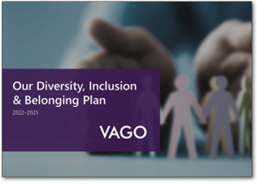 In June 2023 we published our Diversity, Inclusion and Belonging Plan 2022–2025, which comprises the following plans:
In June 2023 we published our Diversity, Inclusion and Belonging Plan 2022–2025, which comprises the following plans:
- Cultural Inclusion Action Plan
- Disability Inclusion and Accessibility Plan
- Gender Equality Action Plan
- LGBTQIA+ Inclusion Action Plan
- Reconciliation Action Plan
We delayed publication of our overall plan to recalibrate it in response to feedback, which indicated we had overcommitted on what was achievable. We worked diligently to refine our overall plan and incorporate actions into existing projects. As a result, it is better suited to our evolving needs as an organisation.
Our overall plan is available on the Corporate publications page of our website.
Reconciliation Action Plan
Our Reconciliation Action Plan (RAP) is an important roadmap that helps us on our journey towards reconciliation with First Nations Australians. The RAP process is made up of 4 steps –Reflect, Innovate, Stretch and Elevate (or RISE).
We engaged 2 Aboriginal advisors to guide us in our journey and ensure that implementation of our RAP includes the voices of First Nations Australians.
This year we took the second step in this journey, with our Innovate RAP being conditionally endorsed by Reconciliation Australia.
We also:
- organised a film screening and facilitated discussion for staff to celebrate National Reconciliation Week
- renewed our platinum partnership with Kinaway, the Victorian Aboriginal Chamber of Commerce, and encouraged staff to attend its cultural training programs.
Pride at VAGO
In June 2023, during Pride Month, we launched Pride at VAGO – a peer-support network for LGBTQIA+ staff and allies.
Pride at VAGO’s mission is to create and maintain a visible presence and channels of communication and advocacy for LGBTQIA+ staff.
The network organises social events and works alongside senior leaders, HR and other internal groups to provide guidance, education and support in how to be a good ally.
Other diversity, inclusion and belonging initiatives
We also:
- introduced a flexible public holiday procedure to allow staff to substitute certain public holidays to an alternative day in accordance with their faith
- regularly communicated to staff about days of significance for diversity and inclusion
- worked on embedding diversity, inclusion and belonging as a leadership mindset and behaviour through our capability frameworks.
Employee benefits and assistance
Volunteer leave
Our staff can access 2 days of paid leave each year to participate in a chosen volunteer program with a registered charity or not-for-profit organisation.
We offer this program over and above other leave entitlements in our enterprise agreement.
VPS Flood Policy
Following the floods across Victoria in October 2022, the governent developed a public sector-wide floods policy to support directly affected staff. This temporary policy remained in place until April 2023.
Under the policy, eligible employees could access additional support and assistance, including:
- up to 30 days paid leave
- up to 8 weeks salary paid in advance.
We made the flood policy available in addition to our Better Normal principles, where staff can choose alternative working arrangements to suit their individual circumstances.
Celebrating our people
All-staff forum and Values Awards
In March 2023, we held our first annual all-staff forum and Values Awards since the pandemic.
This all-day event included an interactive panel discussion with our Strategic Management Group, an audit client-focused scavenger hunt in Melbourne’s CBD and a collaborative painting activity. We finished the day with an awards ceremony recognising staff who exemplify our values of accountability, collaboration innovation and respect.

International Women’s Day Gala Dinner
As a proud supporter of the Institute of Public Administration Australia’s Victorian division’s annual gala dinner for International Women’s Day, on 8 March we once again hosted 2 tables to demonstrate our commitment towards an inclusive and diverse public sector. This year's event featured a treaty and truth-telling discussion with esteemed First Nations Elders and leaders.
VAGO Social Club
Our Social Club continued to organise activities to help staff connect with colleagues and develop networks.
Activities this year included a picnic in the park, book and movie clubs, board game evenings and events for Christmas, Halloween and the end of financial year.
Listening to our people
People matter survey
Each year, the Victorian Public Sector Commission invites employees to provide feedback on their workplace by participating in the People Matter survey.
The 2023 People matter survey ran for 4 weeks from 29 May to 26 June and 81 per cent of VAGO employees took part – an increase from 75 per cent the previous year. Each year we analyse our results and take actions based on the feedback of our staff. Since 2019 we have also published our survey results on our website.
Our results are available at www.audit.vic.gov.au/how-we-are-accountable.
5. Performance statement
6. Our financial management
Download a PDF copy of Section 6. Our financial management.
Appendix A: Workforce profile and gender pay gap
Download a PDF copy of Appendix A: Workforce profile and gender pay gap.
Appendix B: Workplace health and safety
Download a PDF copy of Appendix B: Workplace health and safety.
Appendix C: General executive information
Download a PDF copy of Appendix C: General executive information.
Appendix D: Audit and risk management
Download a PDF copy of Appendix D: Audit and risk management.
Appendix E: Policies and compliance
Download a PDF copy of Appendix E: Policies and compliance.
Appendix F: Additional information available on request
Download a PDF copy of Appendix F: Additional information available on request.
Download Appendix F: Additional information available on request
Appendix G: Disclosure index
Appendix H: Acronyms and abbreviations
Download a PDF copy of Appendix H: Acronyms and abbreviations.

